Understanding and Analysis of Key Changes in Audit Report Requirements
VerifiedAdded on 2023/06/11
|24
|5897
|426
AI Summary
This study aims to identify changes brought about in the ISA and their implications on Australian businesses as considered by auditing firms. The study will make use of epistemology philosophy along with exploratory study techniques. Data of primary as well as second nature will be collected for the purpose of the study.
Contribute Materials
Your contribution can guide someone’s learning journey. Share your
documents today.

ASSESSMENT 4
BUS707 – Applied Business Research
T1 2018
Topic: Understanding and analysis the key changes in the audit report requirements
Student Name:
Student ID:
Subject Name:
[1]
BUS707 – Applied Business Research
T1 2018
Topic: Understanding and analysis the key changes in the audit report requirements
Student Name:
Student ID:
Subject Name:
[1]
Secure Best Marks with AI Grader
Need help grading? Try our AI Grader for instant feedback on your assignments.

Executive Summary
Introduction: Auditing is one of the most integral aspects of financial accounting and corporate
governance in turn.
Research Objective: This study entails identifying changes that has been brought about in the
ISA. Along with possible implications on Australian businesses as considered by Auditing firms.
Theoretical Background: Adhering to financial accounting and auditing standards acts as
compliance towards corporate governance. In light of the new auditing requirement changes
brought about by the international body of auditors post taking in recommendations from various
countries have led to accomplishments of several changes that has been brought about. Changes
to the International Standards
Research Methodology: The study will make use of epistemology philosophy along with
exploratory study techniques. Data of primary as well as second nature will be collected for the
purpose of the study. All possible ethical considerations will be taken into account for
conducting the study appropriately.
[2]
Introduction: Auditing is one of the most integral aspects of financial accounting and corporate
governance in turn.
Research Objective: This study entails identifying changes that has been brought about in the
ISA. Along with possible implications on Australian businesses as considered by Auditing firms.
Theoretical Background: Adhering to financial accounting and auditing standards acts as
compliance towards corporate governance. In light of the new auditing requirement changes
brought about by the international body of auditors post taking in recommendations from various
countries have led to accomplishments of several changes that has been brought about. Changes
to the International Standards
Research Methodology: The study will make use of epistemology philosophy along with
exploratory study techniques. Data of primary as well as second nature will be collected for the
purpose of the study. All possible ethical considerations will be taken into account for
conducting the study appropriately.
[2]
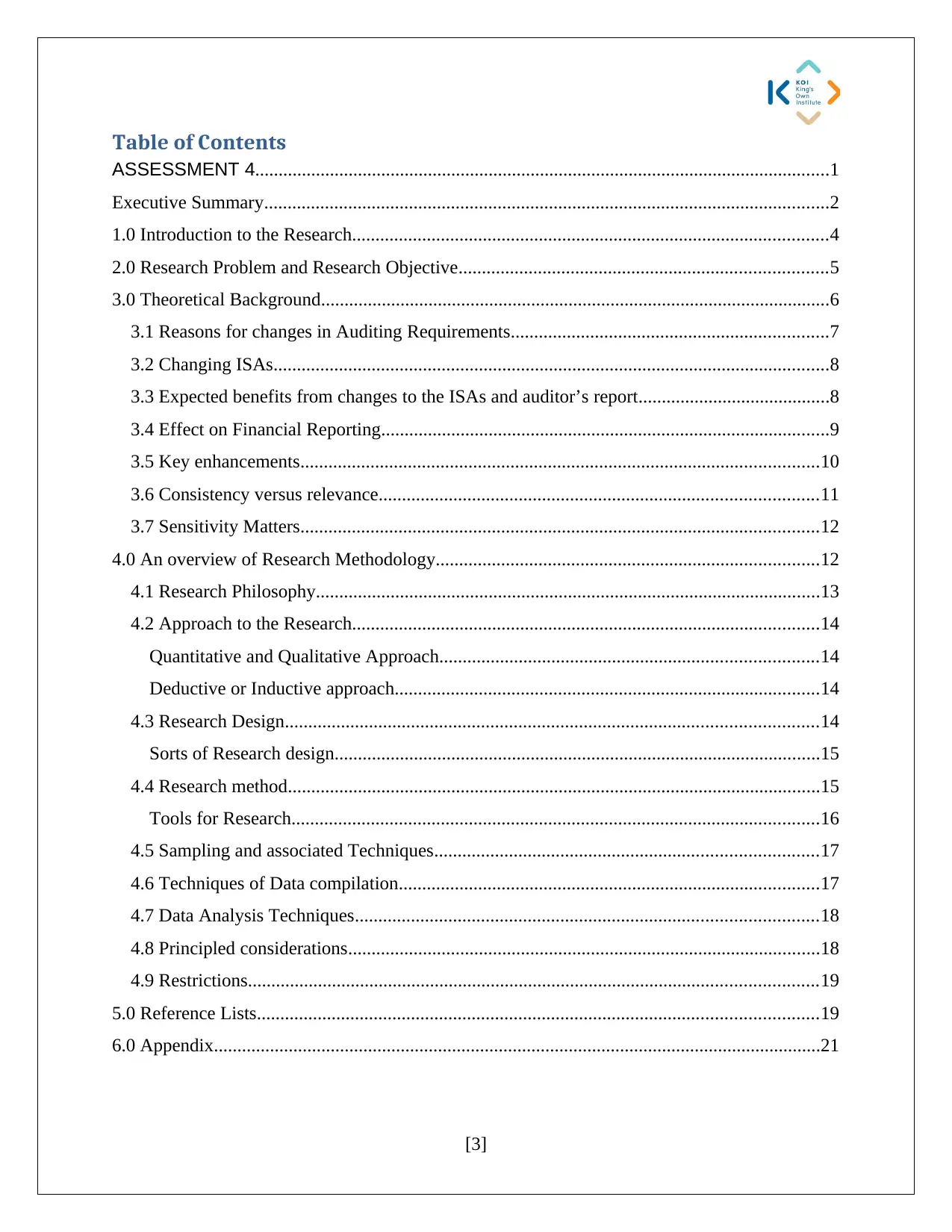
Table of Contents
ASSESSMENT 4...........................................................................................................................1
Executive Summary.........................................................................................................................2
1.0 Introduction to the Research......................................................................................................4
2.0 Research Problem and Research Objective...............................................................................5
3.0 Theoretical Background.............................................................................................................6
3.1 Reasons for changes in Auditing Requirements....................................................................7
3.2 Changing ISAs.......................................................................................................................8
3.3 Expected benefits from changes to the ISAs and auditor’s report.........................................8
3.4 Effect on Financial Reporting................................................................................................9
3.5 Key enhancements...............................................................................................................10
3.6 Consistency versus relevance..............................................................................................11
3.7 Sensitivity Matters...............................................................................................................12
4.0 An overview of Research Methodology..................................................................................12
4.1 Research Philosophy............................................................................................................13
4.2 Approach to the Research....................................................................................................14
Quantitative and Qualitative Approach.................................................................................14
Deductive or Inductive approach...........................................................................................14
4.3 Research Design..................................................................................................................14
Sorts of Research design........................................................................................................15
4.4 Research method..................................................................................................................15
Tools for Research.................................................................................................................16
4.5 Sampling and associated Techniques..................................................................................17
4.6 Techniques of Data compilation..........................................................................................17
4.7 Data Analysis Techniques...................................................................................................18
4.8 Principled considerations.....................................................................................................18
4.9 Restrictions..........................................................................................................................19
5.0 Reference Lists........................................................................................................................19
6.0 Appendix..................................................................................................................................21
[3]
ASSESSMENT 4...........................................................................................................................1
Executive Summary.........................................................................................................................2
1.0 Introduction to the Research......................................................................................................4
2.0 Research Problem and Research Objective...............................................................................5
3.0 Theoretical Background.............................................................................................................6
3.1 Reasons for changes in Auditing Requirements....................................................................7
3.2 Changing ISAs.......................................................................................................................8
3.3 Expected benefits from changes to the ISAs and auditor’s report.........................................8
3.4 Effect on Financial Reporting................................................................................................9
3.5 Key enhancements...............................................................................................................10
3.6 Consistency versus relevance..............................................................................................11
3.7 Sensitivity Matters...............................................................................................................12
4.0 An overview of Research Methodology..................................................................................12
4.1 Research Philosophy............................................................................................................13
4.2 Approach to the Research....................................................................................................14
Quantitative and Qualitative Approach.................................................................................14
Deductive or Inductive approach...........................................................................................14
4.3 Research Design..................................................................................................................14
Sorts of Research design........................................................................................................15
4.4 Research method..................................................................................................................15
Tools for Research.................................................................................................................16
4.5 Sampling and associated Techniques..................................................................................17
4.6 Techniques of Data compilation..........................................................................................17
4.7 Data Analysis Techniques...................................................................................................18
4.8 Principled considerations.....................................................................................................18
4.9 Restrictions..........................................................................................................................19
5.0 Reference Lists........................................................................................................................19
6.0 Appendix..................................................................................................................................21
[3]
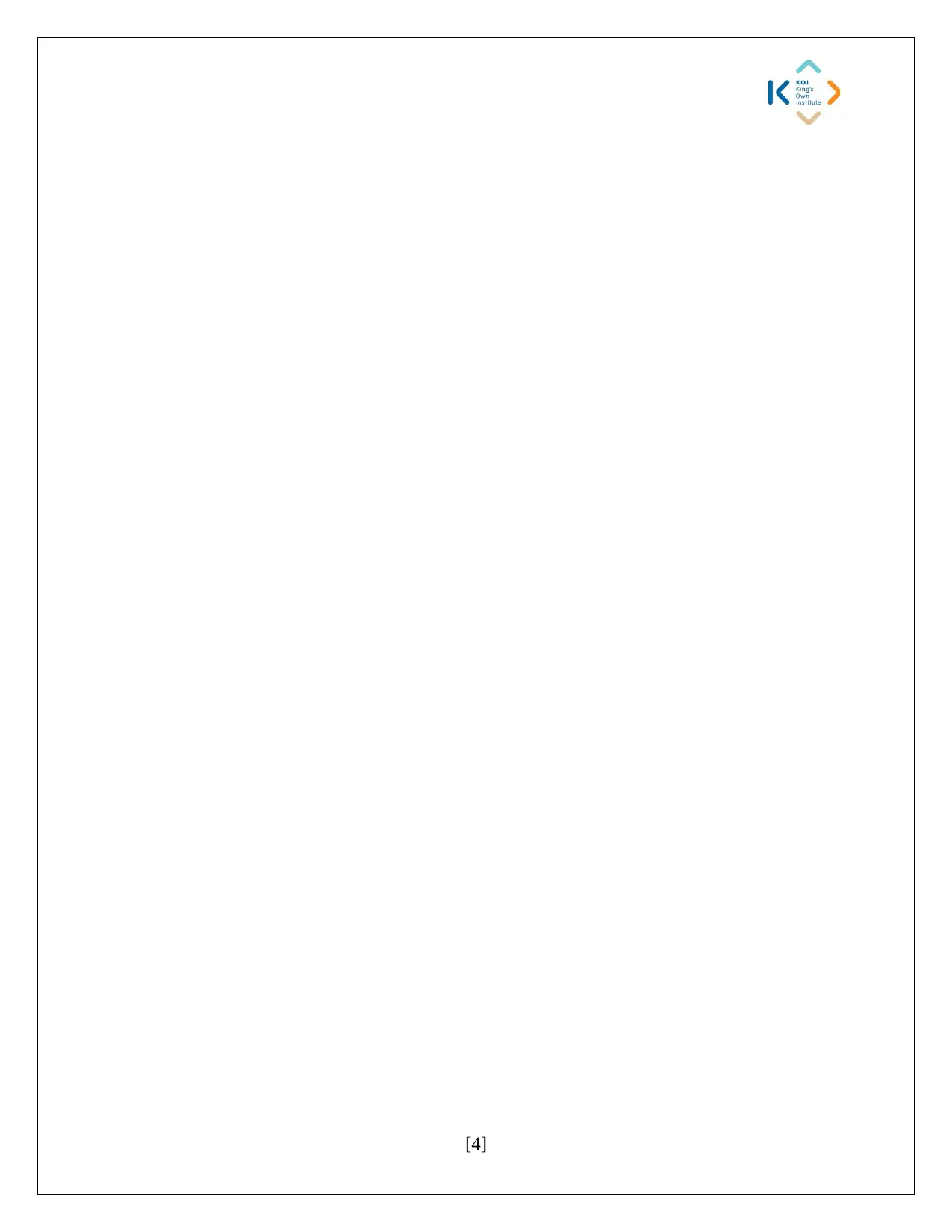
[4]
Secure Best Marks with AI Grader
Need help grading? Try our AI Grader for instant feedback on your assignments.

1.0 Introduction to the Research
Increasing global business diversity and emergence of international corporations have led to
formation of IAASB (International Auditing and Assurance Standards Board) (Lennox &
Pittman, 2010). The Board for IAASB provides several broad frameworks to companies present
worldwide regarding their reporting and auditing standards they need to adhere to. Adhering to
such standards auditing has proved to be beneficial for companies and also allowed them to
comply with various regulatory measures and norms of corporate governance. In short, it has
allowed companies capability to adapt to corporate governance features. While introducing
norms and standards for worldwide companies, there have been several relevant inputs obtained
from countries across the world (Christensen, Glover & Wolfe, 2014). In Australia, corporate
governance board ASIC (Australian Securities and Investment Committee) along with the CPA
(Certified Practicing Accountant) publishes various auditing and accounting requirements that
firms within the country need to adhere to. The Board takes relevant inputs from accounting and
auditing firms across Australia in order to understand new regulations impact on the Australian
firms. Therefore, the scope of the current analysis pertains to understanding relevant auditing
requirement changes that have been brought about in the recent period and there implications
from the point of view of various auditing firms in the country that have been covered in earlier
literature reviews.
2.0 Research Problem and Research Objective
Auditing is a major requirement across all countries that all companies need to apply. While the
international auditing board devises new standards and regulations, they are adapted across by
the countries and across all organizations (Bedard et al., 2012). Complying with new set of
standards that has been currently proposed has several positive impacts and is in accordance to
[5]
Increasing global business diversity and emergence of international corporations have led to
formation of IAASB (International Auditing and Assurance Standards Board) (Lennox &
Pittman, 2010). The Board for IAASB provides several broad frameworks to companies present
worldwide regarding their reporting and auditing standards they need to adhere to. Adhering to
such standards auditing has proved to be beneficial for companies and also allowed them to
comply with various regulatory measures and norms of corporate governance. In short, it has
allowed companies capability to adapt to corporate governance features. While introducing
norms and standards for worldwide companies, there have been several relevant inputs obtained
from countries across the world (Christensen, Glover & Wolfe, 2014). In Australia, corporate
governance board ASIC (Australian Securities and Investment Committee) along with the CPA
(Certified Practicing Accountant) publishes various auditing and accounting requirements that
firms within the country need to adhere to. The Board takes relevant inputs from accounting and
auditing firms across Australia in order to understand new regulations impact on the Australian
firms. Therefore, the scope of the current analysis pertains to understanding relevant auditing
requirement changes that have been brought about in the recent period and there implications
from the point of view of various auditing firms in the country that have been covered in earlier
literature reviews.
2.0 Research Problem and Research Objective
Auditing is a major requirement across all countries that all companies need to apply. While the
international auditing board devises new standards and regulations, they are adapted across by
the countries and across all organizations (Bedard et al., 2012). Complying with new set of
standards that has been currently proposed has several positive impacts and is in accordance to
[5]
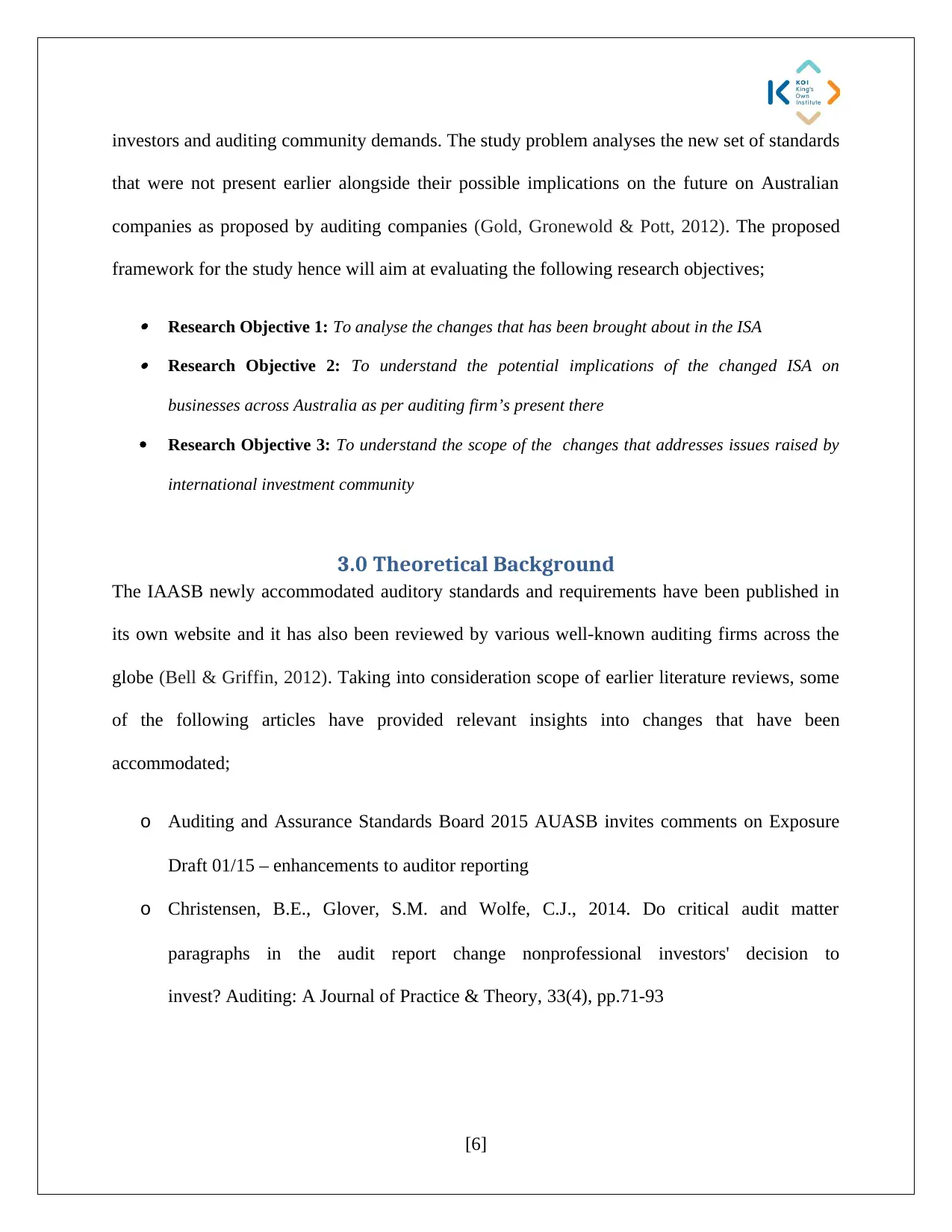
investors and auditing community demands. The study problem analyses the new set of standards
that were not present earlier alongside their possible implications on the future on Australian
companies as proposed by auditing companies (Gold, Gronewold & Pott, 2012). The proposed
framework for the study hence will aim at evaluating the following research objectives;
Research Objective 1: To analyse the changes that has been brought about in the ISA Research Objective 2: To understand the potential implications of the changed ISA on
businesses across Australia as per auditing firm’s present there
Research Objective 3: To understand the scope of the changes that addresses issues raised by
international investment community
3.0 Theoretical Background
The IAASB newly accommodated auditory standards and requirements have been published in
its own website and it has also been reviewed by various well-known auditing firms across the
globe (Bell & Griffin, 2012). Taking into consideration scope of earlier literature reviews, some
of the following articles have provided relevant insights into changes that have been
accommodated;
o Auditing and Assurance Standards Board 2015 AUASB invites comments on Exposure
Draft 01/15 – enhancements to auditor reporting
o Christensen, B.E., Glover, S.M. and Wolfe, C.J., 2014. Do critical audit matter
paragraphs in the audit report change nonprofessional investors' decision to
invest? Auditing: A Journal of Practice & Theory, 33(4), pp.71-93
[6]
that were not present earlier alongside their possible implications on the future on Australian
companies as proposed by auditing companies (Gold, Gronewold & Pott, 2012). The proposed
framework for the study hence will aim at evaluating the following research objectives;
Research Objective 1: To analyse the changes that has been brought about in the ISA Research Objective 2: To understand the potential implications of the changed ISA on
businesses across Australia as per auditing firm’s present there
Research Objective 3: To understand the scope of the changes that addresses issues raised by
international investment community
3.0 Theoretical Background
The IAASB newly accommodated auditory standards and requirements have been published in
its own website and it has also been reviewed by various well-known auditing firms across the
globe (Bell & Griffin, 2012). Taking into consideration scope of earlier literature reviews, some
of the following articles have provided relevant insights into changes that have been
accommodated;
o Auditing and Assurance Standards Board 2015 AUASB invites comments on Exposure
Draft 01/15 – enhancements to auditor reporting
o Christensen, B.E., Glover, S.M. and Wolfe, C.J., 2014. Do critical audit matter
paragraphs in the audit report change nonprofessional investors' decision to
invest? Auditing: A Journal of Practice & Theory, 33(4), pp.71-93
[6]
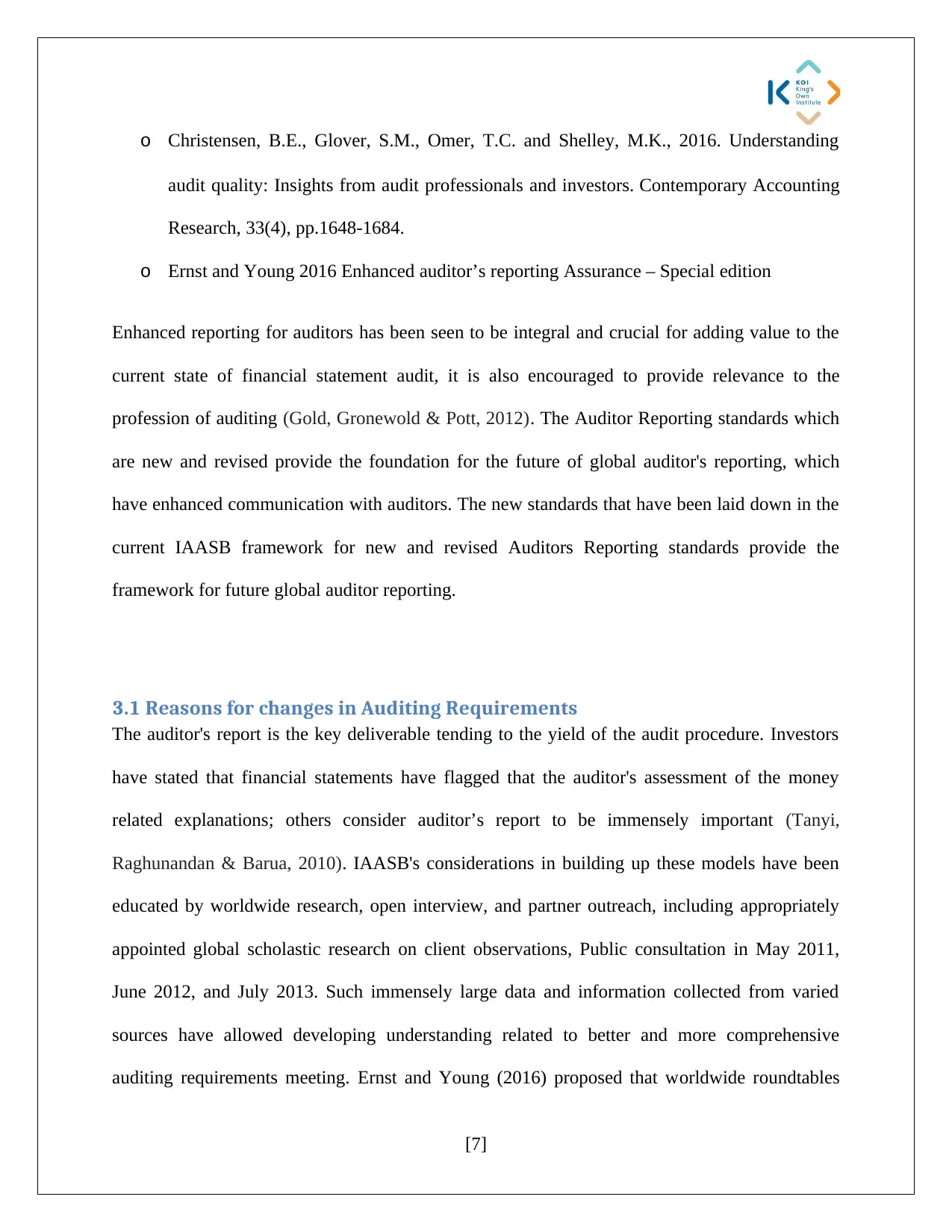
o Christensen, B.E., Glover, S.M., Omer, T.C. and Shelley, M.K., 2016. Understanding
audit quality: Insights from audit professionals and investors. Contemporary Accounting
Research, 33(4), pp.1648-1684.
o Ernst and Young 2016 Enhanced auditor’s reporting Assurance – Special edition
Enhanced reporting for auditors has been seen to be integral and crucial for adding value to the
current state of financial statement audit, it is also encouraged to provide relevance to the
profession of auditing (Gold, Gronewold & Pott, 2012). The Auditor Reporting standards which
are new and revised provide the foundation for the future of global auditor's reporting, which
have enhanced communication with auditors. The new standards that have been laid down in the
current IAASB framework for new and revised Auditors Reporting standards provide the
framework for future global auditor reporting.
3.1 Reasons for changes in Auditing Requirements
The auditor's report is the key deliverable tending to the yield of the audit procedure. Investors
have stated that financial statements have flagged that the auditor's assessment of the money
related explanations; others consider auditor’s report to be immensely important (Tanyi,
Raghunandan & Barua, 2010). IAASB's considerations in building up these models have been
educated by worldwide research, open interview, and partner outreach, including appropriately
appointed global scholastic research on client observations, Public consultation in May 2011,
June 2012, and July 2013. Such immensely large data and information collected from varied
sources have allowed developing understanding related to better and more comprehensive
auditing requirements meeting. Ernst and Young (2016) proposed that worldwide roundtables
[7]
audit quality: Insights from audit professionals and investors. Contemporary Accounting
Research, 33(4), pp.1648-1684.
o Ernst and Young 2016 Enhanced auditor’s reporting Assurance – Special edition
Enhanced reporting for auditors has been seen to be integral and crucial for adding value to the
current state of financial statement audit, it is also encouraged to provide relevance to the
profession of auditing (Gold, Gronewold & Pott, 2012). The Auditor Reporting standards which
are new and revised provide the foundation for the future of global auditor's reporting, which
have enhanced communication with auditors. The new standards that have been laid down in the
current IAASB framework for new and revised Auditors Reporting standards provide the
framework for future global auditor reporting.
3.1 Reasons for changes in Auditing Requirements
The auditor's report is the key deliverable tending to the yield of the audit procedure. Investors
have stated that financial statements have flagged that the auditor's assessment of the money
related explanations; others consider auditor’s report to be immensely important (Tanyi,
Raghunandan & Barua, 2010). IAASB's considerations in building up these models have been
educated by worldwide research, open interview, and partner outreach, including appropriately
appointed global scholastic research on client observations, Public consultation in May 2011,
June 2012, and July 2013. Such immensely large data and information collected from varied
sources have allowed developing understanding related to better and more comprehensive
auditing requirements meeting. Ernst and Young (2016) proposed that worldwide roundtables
[7]
Paraphrase This Document
Need a fresh take? Get an instant paraphrase of this document with our AI Paraphraser
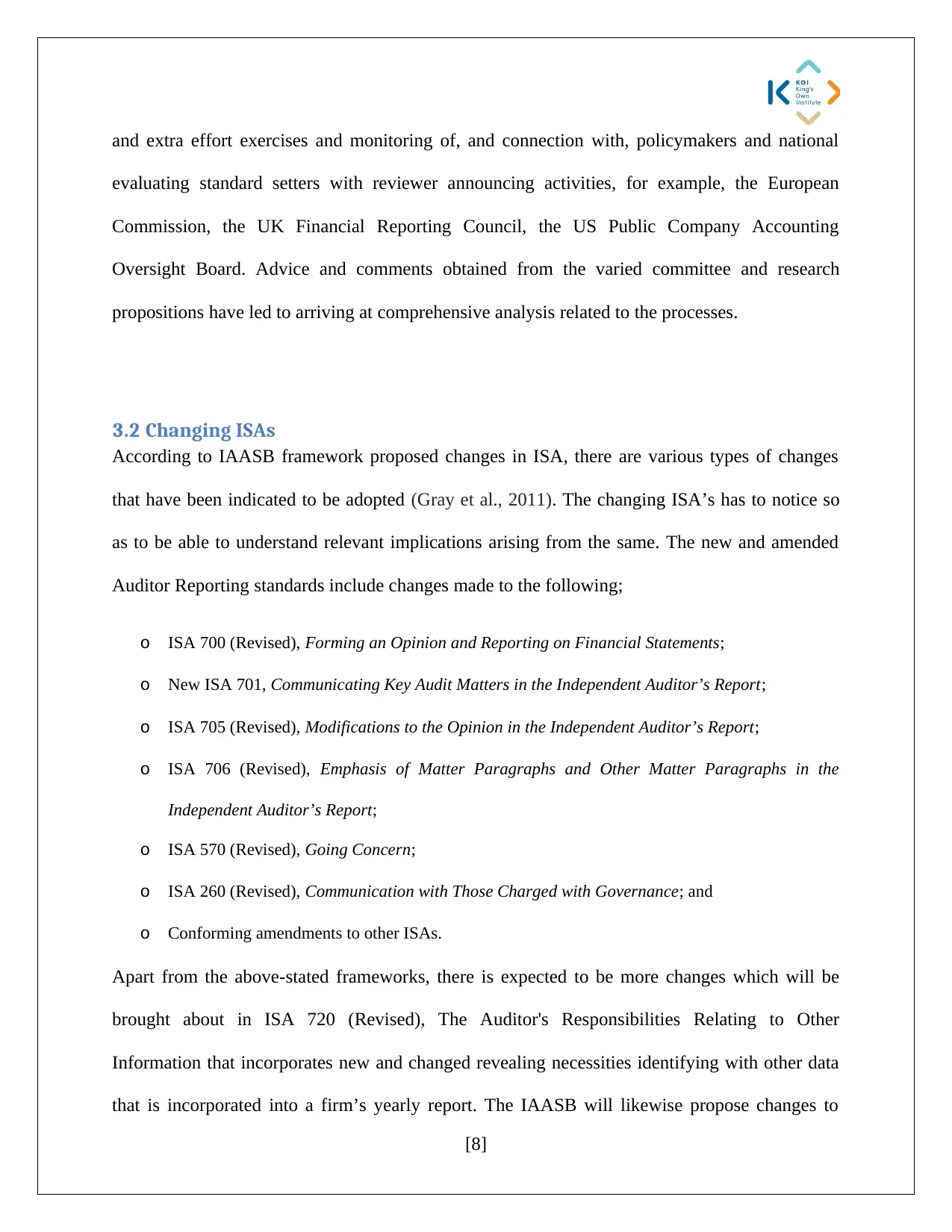
and extra effort exercises and monitoring of, and connection with, policymakers and national
evaluating standard setters with reviewer announcing activities, for example, the European
Commission, the UK Financial Reporting Council, the US Public Company Accounting
Oversight Board. Advice and comments obtained from the varied committee and research
propositions have led to arriving at comprehensive analysis related to the processes.
3.2 Changing ISAs
According to IAASB framework proposed changes in ISA, there are various types of changes
that have been indicated to be adopted (Gray et al., 2011). The changing ISA’s has to notice so
as to be able to understand relevant implications arising from the same. The new and amended
Auditor Reporting standards include changes made to the following;
o ISA 700 (Revised), Forming an Opinion and Reporting on Financial Statements;
o New ISA 701, Communicating Key Audit Matters in the Independent Auditor’s Report;
o ISA 705 (Revised), Modifications to the Opinion in the Independent Auditor’s Report;
o ISA 706 (Revised), Emphasis of Matter Paragraphs and Other Matter Paragraphs in the
Independent Auditor’s Report;
o ISA 570 (Revised), Going Concern;
o ISA 260 (Revised), Communication with Those Charged with Governance; and
o Conforming amendments to other ISAs.
Apart from the above-stated frameworks, there is expected to be more changes which will be
brought about in ISA 720 (Revised), The Auditor's Responsibilities Relating to Other
Information that incorporates new and changed revealing necessities identifying with other data
that is incorporated into a firm’s yearly report. The IAASB will likewise propose changes to
[8]
evaluating standard setters with reviewer announcing activities, for example, the European
Commission, the UK Financial Reporting Council, the US Public Company Accounting
Oversight Board. Advice and comments obtained from the varied committee and research
propositions have led to arriving at comprehensive analysis related to the processes.
3.2 Changing ISAs
According to IAASB framework proposed changes in ISA, there are various types of changes
that have been indicated to be adopted (Gray et al., 2011). The changing ISA’s has to notice so
as to be able to understand relevant implications arising from the same. The new and amended
Auditor Reporting standards include changes made to the following;
o ISA 700 (Revised), Forming an Opinion and Reporting on Financial Statements;
o New ISA 701, Communicating Key Audit Matters in the Independent Auditor’s Report;
o ISA 705 (Revised), Modifications to the Opinion in the Independent Auditor’s Report;
o ISA 706 (Revised), Emphasis of Matter Paragraphs and Other Matter Paragraphs in the
Independent Auditor’s Report;
o ISA 570 (Revised), Going Concern;
o ISA 260 (Revised), Communication with Those Charged with Governance; and
o Conforming amendments to other ISAs.
Apart from the above-stated frameworks, there is expected to be more changes which will be
brought about in ISA 720 (Revised), The Auditor's Responsibilities Relating to Other
Information that incorporates new and changed revealing necessities identifying with other data
that is incorporated into a firm’s yearly report. The IAASB will likewise propose changes to
[8]

reviewer's reports on uncommon reason monetary explanations in a destined to be discharged
introduction draft.
3.3 Expected benefits from changes to the ISA and auditor's report
The auditor's report is the key deliverable tending to the yield of the review procedure. The
IAASB expects for its new and reconsidered Auditor’s reporting norms to bring about a
reviewer's report that builds the trust in the review and the money related proclamations, which is
in the general population premium. Carcello, Hermanson, and Ye (2011) evaluated the IAASB
trusts that notwithstanding the expanded straightforwardness and improved enlightening
estimation of the auditor's report, changes to reviewer revealing will likewise have the advantage
of improved correspondences between the auditor and investors. It is also able to maintain
communication amongst reviewers and those accused of administration. Expanded consideration
by the administration and those accused of administration (e.g., the review board of trustees) to
the exposures in the budgetary articulations to which reference is made in the auditor's report. In
order to analyze focal point of the auditor on issues to be accounted for, which could buy
implication result in an expansion in proficient distrust. Implications of new standards in auditing
are bound to impact communication amongst various stakeholders of the business with the
auditor which will enhance the effectiveness of the overall procedure.
3.4 Effect on Financial Reporting
The improvements to the auditor's report expand upon the fundamental ideas in an ISA review
tending to how a hazard based review is performed and what is required to be spoken with those
accused of administration. The progressions to the ISAs don't change the hidden work exertion
required in an ISA review, yet rather center on expanding straightforwardness about the review
[9]
introduction draft.
3.3 Expected benefits from changes to the ISA and auditor's report
The auditor's report is the key deliverable tending to the yield of the review procedure. The
IAASB expects for its new and reconsidered Auditor’s reporting norms to bring about a
reviewer's report that builds the trust in the review and the money related proclamations, which is
in the general population premium. Carcello, Hermanson, and Ye (2011) evaluated the IAASB
trusts that notwithstanding the expanded straightforwardness and improved enlightening
estimation of the auditor's report, changes to reviewer revealing will likewise have the advantage
of improved correspondences between the auditor and investors. It is also able to maintain
communication amongst reviewers and those accused of administration. Expanded consideration
by the administration and those accused of administration (e.g., the review board of trustees) to
the exposures in the budgetary articulations to which reference is made in the auditor's report. In
order to analyze focal point of the auditor on issues to be accounted for, which could buy
implication result in an expansion in proficient distrust. Implications of new standards in auditing
are bound to impact communication amongst various stakeholders of the business with the
auditor which will enhance the effectiveness of the overall procedure.
3.4 Effect on Financial Reporting
The improvements to the auditor's report expand upon the fundamental ideas in an ISA review
tending to how a hazard based review is performed and what is required to be spoken with those
accused of administration. The progressions to the ISAs don't change the hidden work exertion
required in an ISA review, yet rather center on expanding straightforwardness about the review
[9]
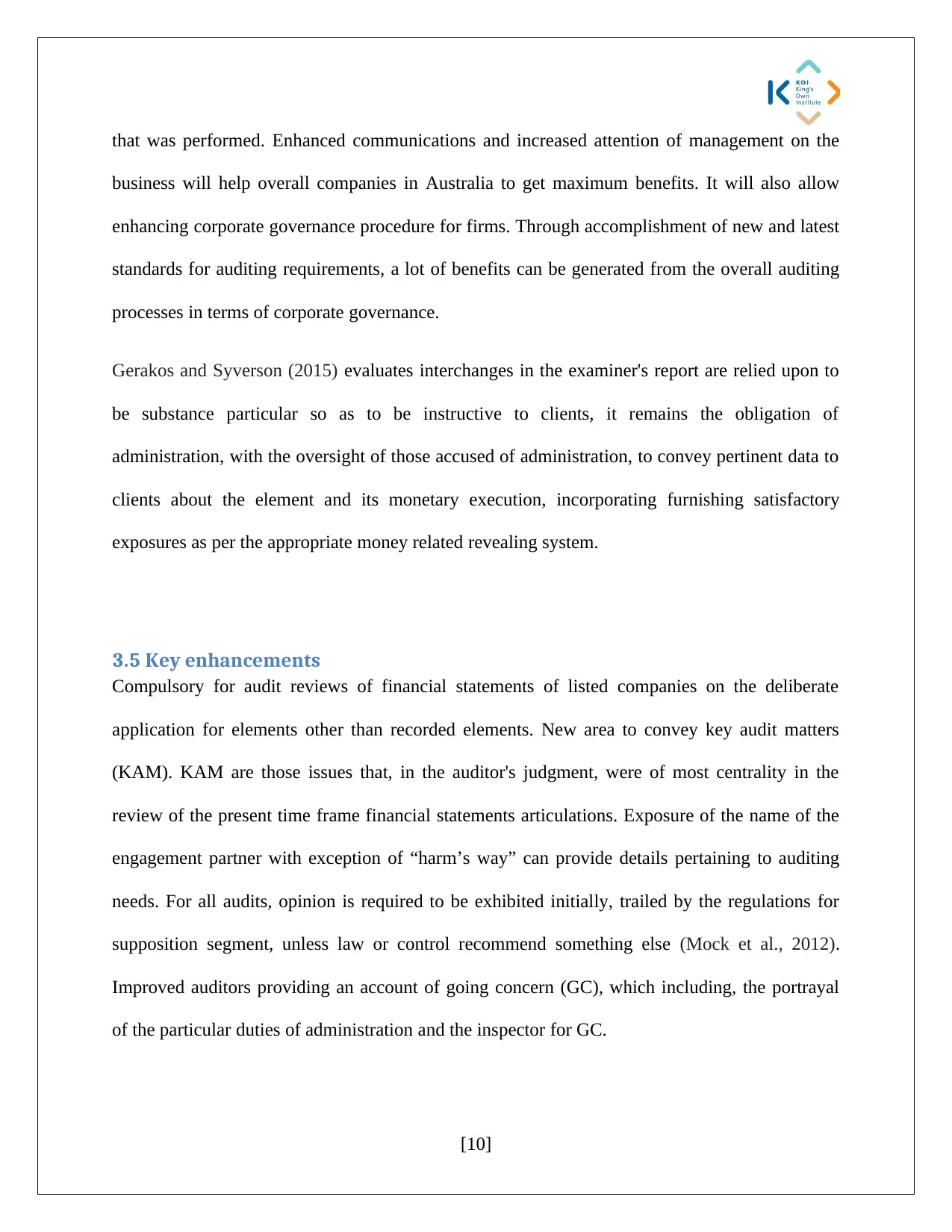
that was performed. Enhanced communications and increased attention of management on the
business will help overall companies in Australia to get maximum benefits. It will also allow
enhancing corporate governance procedure for firms. Through accomplishment of new and latest
standards for auditing requirements, a lot of benefits can be generated from the overall auditing
processes in terms of corporate governance.
Gerakos and Syverson (2015) evaluates interchanges in the examiner's report are relied upon to
be substance particular so as to be instructive to clients, it remains the obligation of
administration, with the oversight of those accused of administration, to convey pertinent data to
clients about the element and its monetary execution, incorporating furnishing satisfactory
exposures as per the appropriate money related revealing system.
3.5 Key enhancements
Compulsory for audit reviews of financial statements of listed companies on the deliberate
application for elements other than recorded elements. New area to convey key audit matters
(KAM). KAM are those issues that, in the auditor's judgment, were of most centrality in the
review of the present time frame financial statements articulations. Exposure of the name of the
engagement partner with exception of “harm’s way” can provide details pertaining to auditing
needs. For all audits, opinion is required to be exhibited initially, trailed by the regulations for
supposition segment, unless law or control recommend something else (Mock et al., 2012).
Improved auditors providing an account of going concern (GC), which including, the portrayal
of the particular duties of administration and the inspector for GC.
[10]
business will help overall companies in Australia to get maximum benefits. It will also allow
enhancing corporate governance procedure for firms. Through accomplishment of new and latest
standards for auditing requirements, a lot of benefits can be generated from the overall auditing
processes in terms of corporate governance.
Gerakos and Syverson (2015) evaluates interchanges in the examiner's report are relied upon to
be substance particular so as to be instructive to clients, it remains the obligation of
administration, with the oversight of those accused of administration, to convey pertinent data to
clients about the element and its monetary execution, incorporating furnishing satisfactory
exposures as per the appropriate money related revealing system.
3.5 Key enhancements
Compulsory for audit reviews of financial statements of listed companies on the deliberate
application for elements other than recorded elements. New area to convey key audit matters
(KAM). KAM are those issues that, in the auditor's judgment, were of most centrality in the
review of the present time frame financial statements articulations. Exposure of the name of the
engagement partner with exception of “harm’s way” can provide details pertaining to auditing
needs. For all audits, opinion is required to be exhibited initially, trailed by the regulations for
supposition segment, unless law or control recommend something else (Mock et al., 2012).
Improved auditors providing an account of going concern (GC), which including, the portrayal
of the particular duties of administration and the inspector for GC.
[10]
Secure Best Marks with AI Grader
Need help grading? Try our AI Grader for instant feedback on your assignments.
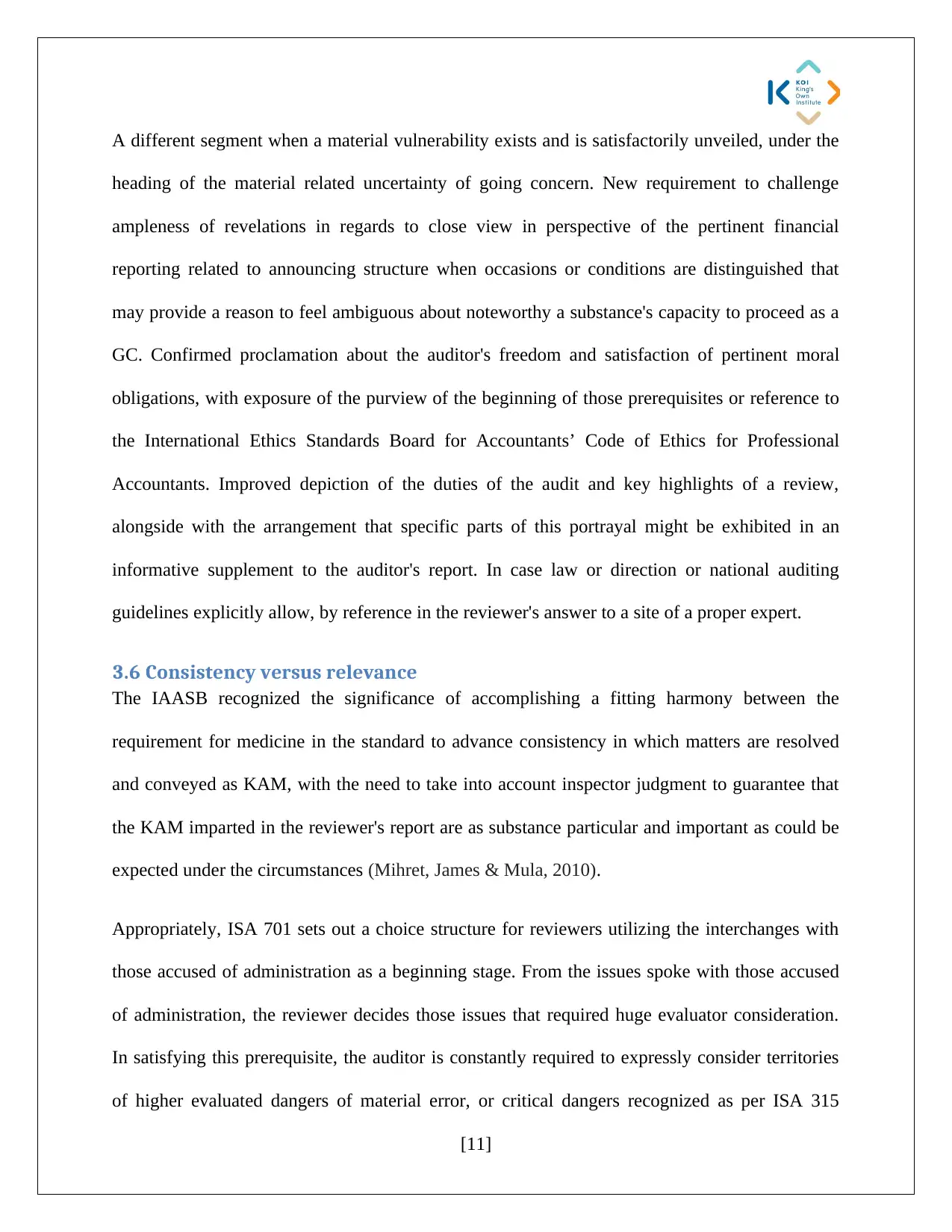
A different segment when a material vulnerability exists and is satisfactorily unveiled, under the
heading of the material related uncertainty of going concern. New requirement to challenge
ampleness of revelations in regards to close view in perspective of the pertinent financial
reporting related to announcing structure when occasions or conditions are distinguished that
may provide a reason to feel ambiguous about noteworthy a substance's capacity to proceed as a
GC. Confirmed proclamation about the auditor's freedom and satisfaction of pertinent moral
obligations, with exposure of the purview of the beginning of those prerequisites or reference to
the International Ethics Standards Board for Accountants’ Code of Ethics for Professional
Accountants. Improved depiction of the duties of the audit and key highlights of a review,
alongside with the arrangement that specific parts of this portrayal might be exhibited in an
informative supplement to the auditor's report. In case law or direction or national auditing
guidelines explicitly allow, by reference in the reviewer's answer to a site of a proper expert.
3.6 Consistency versus relevance
The IAASB recognized the significance of accomplishing a fitting harmony between the
requirement for medicine in the standard to advance consistency in which matters are resolved
and conveyed as KAM, with the need to take into account inspector judgment to guarantee that
the KAM imparted in the reviewer's report are as substance particular and important as could be
expected under the circumstances (Mihret, James & Mula, 2010).
Appropriately, ISA 701 sets out a choice structure for reviewers utilizing the interchanges with
those accused of administration as a beginning stage. From the issues spoke with those accused
of administration, the reviewer decides those issues that required huge evaluator consideration.
In satisfying this prerequisite, the auditor is constantly required to expressly consider territories
of higher evaluated dangers of material error, or critical dangers recognized as per ISA 315
[11]
heading of the material related uncertainty of going concern. New requirement to challenge
ampleness of revelations in regards to close view in perspective of the pertinent financial
reporting related to announcing structure when occasions or conditions are distinguished that
may provide a reason to feel ambiguous about noteworthy a substance's capacity to proceed as a
GC. Confirmed proclamation about the auditor's freedom and satisfaction of pertinent moral
obligations, with exposure of the purview of the beginning of those prerequisites or reference to
the International Ethics Standards Board for Accountants’ Code of Ethics for Professional
Accountants. Improved depiction of the duties of the audit and key highlights of a review,
alongside with the arrangement that specific parts of this portrayal might be exhibited in an
informative supplement to the auditor's report. In case law or direction or national auditing
guidelines explicitly allow, by reference in the reviewer's answer to a site of a proper expert.
3.6 Consistency versus relevance
The IAASB recognized the significance of accomplishing a fitting harmony between the
requirement for medicine in the standard to advance consistency in which matters are resolved
and conveyed as KAM, with the need to take into account inspector judgment to guarantee that
the KAM imparted in the reviewer's report are as substance particular and important as could be
expected under the circumstances (Mihret, James & Mula, 2010).
Appropriately, ISA 701 sets out a choice structure for reviewers utilizing the interchanges with
those accused of administration as a beginning stage. From the issues spoke with those accused
of administration, the reviewer decides those issues that required huge evaluator consideration.
In satisfying this prerequisite, the auditor is constantly required to expressly consider territories
of higher evaluated dangers of material error, or critical dangers recognized as per ISA 315
[11]
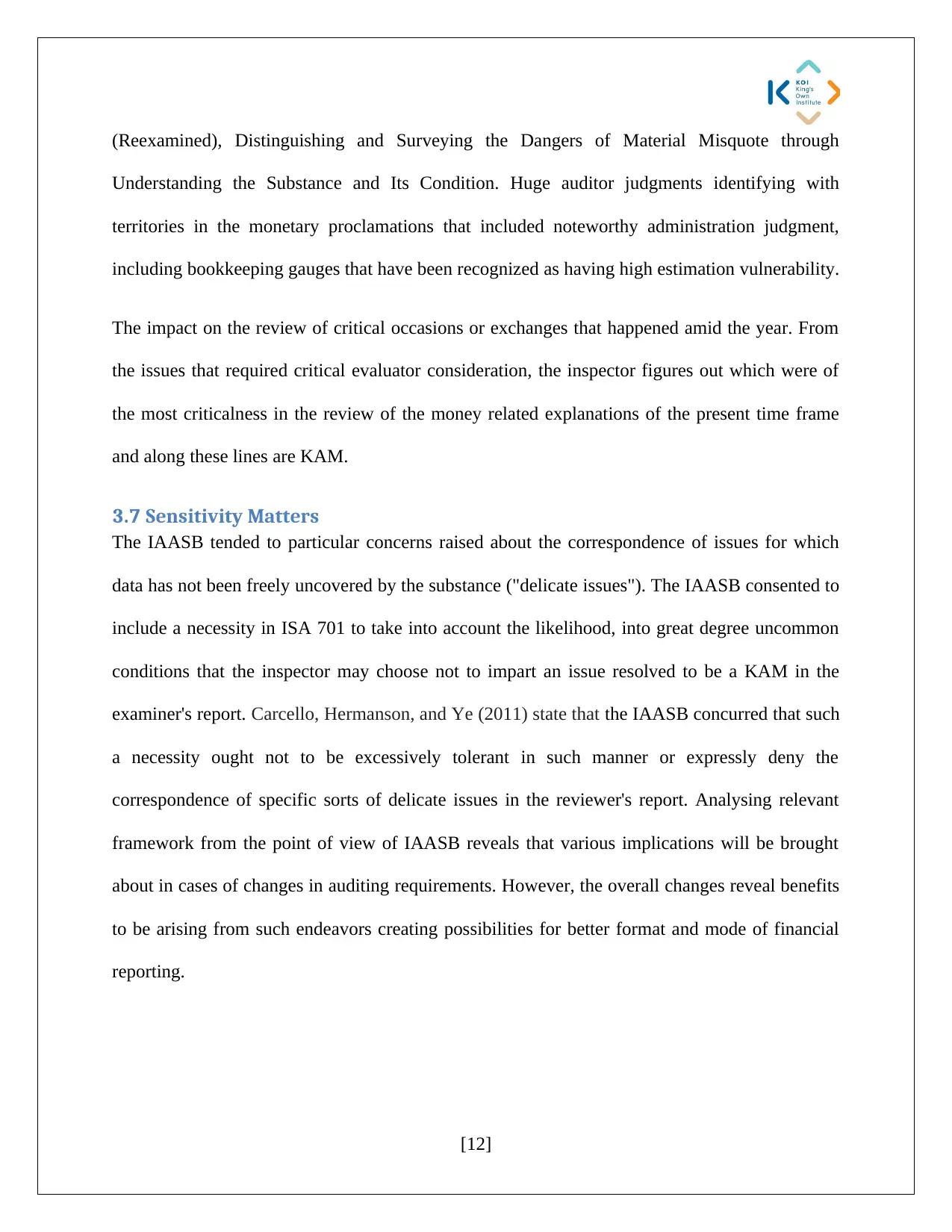
(Reexamined), Distinguishing and Surveying the Dangers of Material Misquote through
Understanding the Substance and Its Condition. Huge auditor judgments identifying with
territories in the monetary proclamations that included noteworthy administration judgment,
including bookkeeping gauges that have been recognized as having high estimation vulnerability.
The impact on the review of critical occasions or exchanges that happened amid the year. From
the issues that required critical evaluator consideration, the inspector figures out which were of
the most criticalness in the review of the money related explanations of the present time frame
and along these lines are KAM.
3.7 Sensitivity Matters
The IAASB tended to particular concerns raised about the correspondence of issues for which
data has not been freely uncovered by the substance ("delicate issues"). The IAASB consented to
include a necessity in ISA 701 to take into account the likelihood, into great degree uncommon
conditions that the inspector may choose not to impart an issue resolved to be a KAM in the
examiner's report. Carcello, Hermanson, and Ye (2011) state that the IAASB concurred that such
a necessity ought not to be excessively tolerant in such manner or expressly deny the
correspondence of specific sorts of delicate issues in the reviewer's report. Analysing relevant
framework from the point of view of IAASB reveals that various implications will be brought
about in cases of changes in auditing requirements. However, the overall changes reveal benefits
to be arising from such endeavors creating possibilities for better format and mode of financial
reporting.
[12]
Understanding the Substance and Its Condition. Huge auditor judgments identifying with
territories in the monetary proclamations that included noteworthy administration judgment,
including bookkeeping gauges that have been recognized as having high estimation vulnerability.
The impact on the review of critical occasions or exchanges that happened amid the year. From
the issues that required critical evaluator consideration, the inspector figures out which were of
the most criticalness in the review of the money related explanations of the present time frame
and along these lines are KAM.
3.7 Sensitivity Matters
The IAASB tended to particular concerns raised about the correspondence of issues for which
data has not been freely uncovered by the substance ("delicate issues"). The IAASB consented to
include a necessity in ISA 701 to take into account the likelihood, into great degree uncommon
conditions that the inspector may choose not to impart an issue resolved to be a KAM in the
examiner's report. Carcello, Hermanson, and Ye (2011) state that the IAASB concurred that such
a necessity ought not to be excessively tolerant in such manner or expressly deny the
correspondence of specific sorts of delicate issues in the reviewer's report. Analysing relevant
framework from the point of view of IAASB reveals that various implications will be brought
about in cases of changes in auditing requirements. However, the overall changes reveal benefits
to be arising from such endeavors creating possibilities for better format and mode of financial
reporting.
[12]
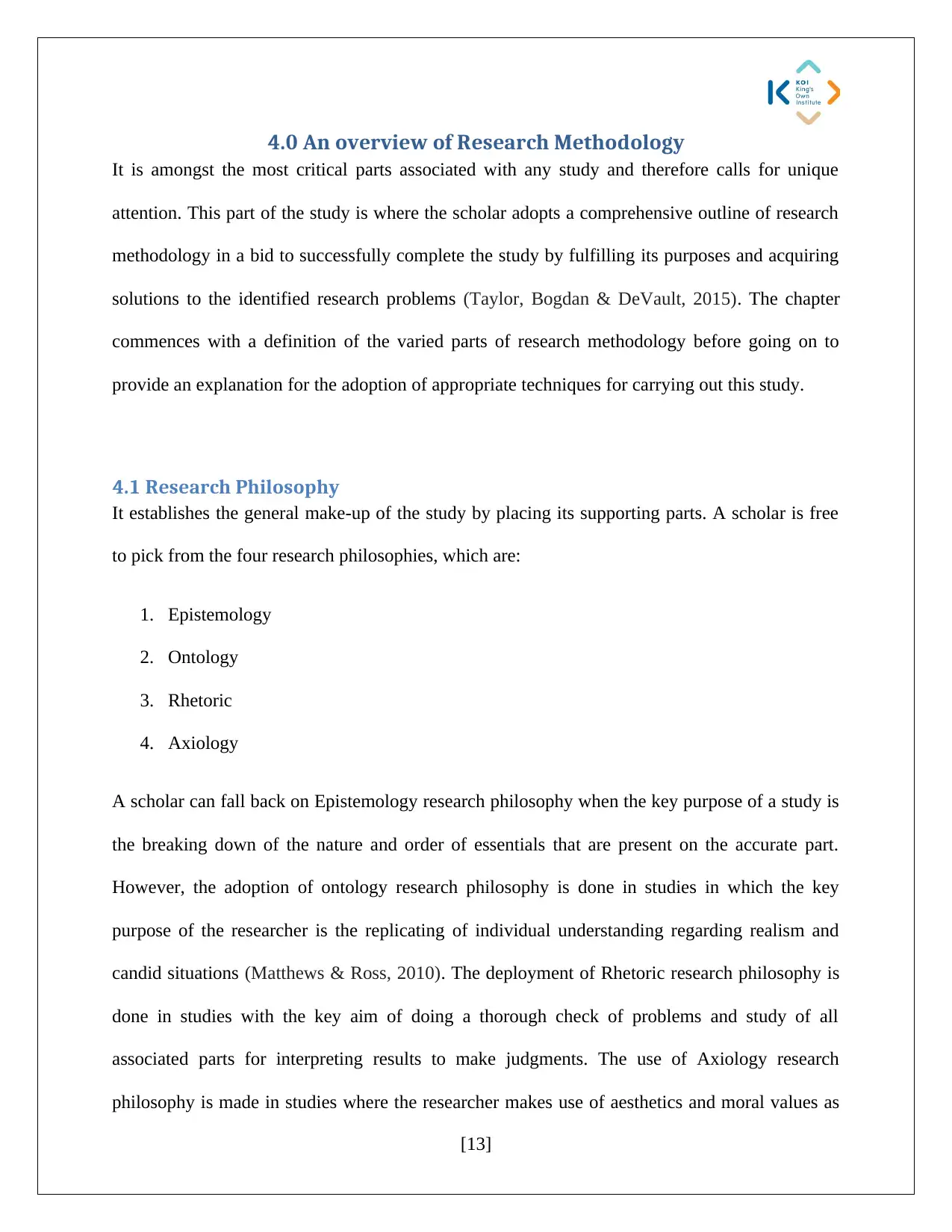
4.0 An overview of Research Methodology
It is amongst the most critical parts associated with any study and therefore calls for unique
attention. This part of the study is where the scholar adopts a comprehensive outline of research
methodology in a bid to successfully complete the study by fulfilling its purposes and acquiring
solutions to the identified research problems (Taylor, Bogdan & DeVault, 2015). The chapter
commences with a definition of the varied parts of research methodology before going on to
provide an explanation for the adoption of appropriate techniques for carrying out this study.
4.1 Research Philosophy
It establishes the general make-up of the study by placing its supporting parts. A scholar is free
to pick from the four research philosophies, which are:
1. Epistemology
2. Ontology
3. Rhetoric
4. Axiology
A scholar can fall back on Epistemology research philosophy when the key purpose of a study is
the breaking down of the nature and order of essentials that are present on the accurate part.
However, the adoption of ontology research philosophy is done in studies in which the key
purpose of the researcher is the replicating of individual understanding regarding realism and
candid situations (Matthews & Ross, 2010). The deployment of Rhetoric research philosophy is
done in studies with the key aim of doing a thorough check of problems and study of all
associated parts for interpreting results to make judgments. The use of Axiology research
philosophy is made in studies where the researcher makes use of aesthetics and moral values as
[13]
It is amongst the most critical parts associated with any study and therefore calls for unique
attention. This part of the study is where the scholar adopts a comprehensive outline of research
methodology in a bid to successfully complete the study by fulfilling its purposes and acquiring
solutions to the identified research problems (Taylor, Bogdan & DeVault, 2015). The chapter
commences with a definition of the varied parts of research methodology before going on to
provide an explanation for the adoption of appropriate techniques for carrying out this study.
4.1 Research Philosophy
It establishes the general make-up of the study by placing its supporting parts. A scholar is free
to pick from the four research philosophies, which are:
1. Epistemology
2. Ontology
3. Rhetoric
4. Axiology
A scholar can fall back on Epistemology research philosophy when the key purpose of a study is
the breaking down of the nature and order of essentials that are present on the accurate part.
However, the adoption of ontology research philosophy is done in studies in which the key
purpose of the researcher is the replicating of individual understanding regarding realism and
candid situations (Matthews & Ross, 2010). The deployment of Rhetoric research philosophy is
done in studies with the key aim of doing a thorough check of problems and study of all
associated parts for interpreting results to make judgments. The use of Axiology research
philosophy is made in studies where the researcher makes use of aesthetics and moral values as
[13]
Paraphrase This Document
Need a fresh take? Get an instant paraphrase of this document with our AI Paraphraser
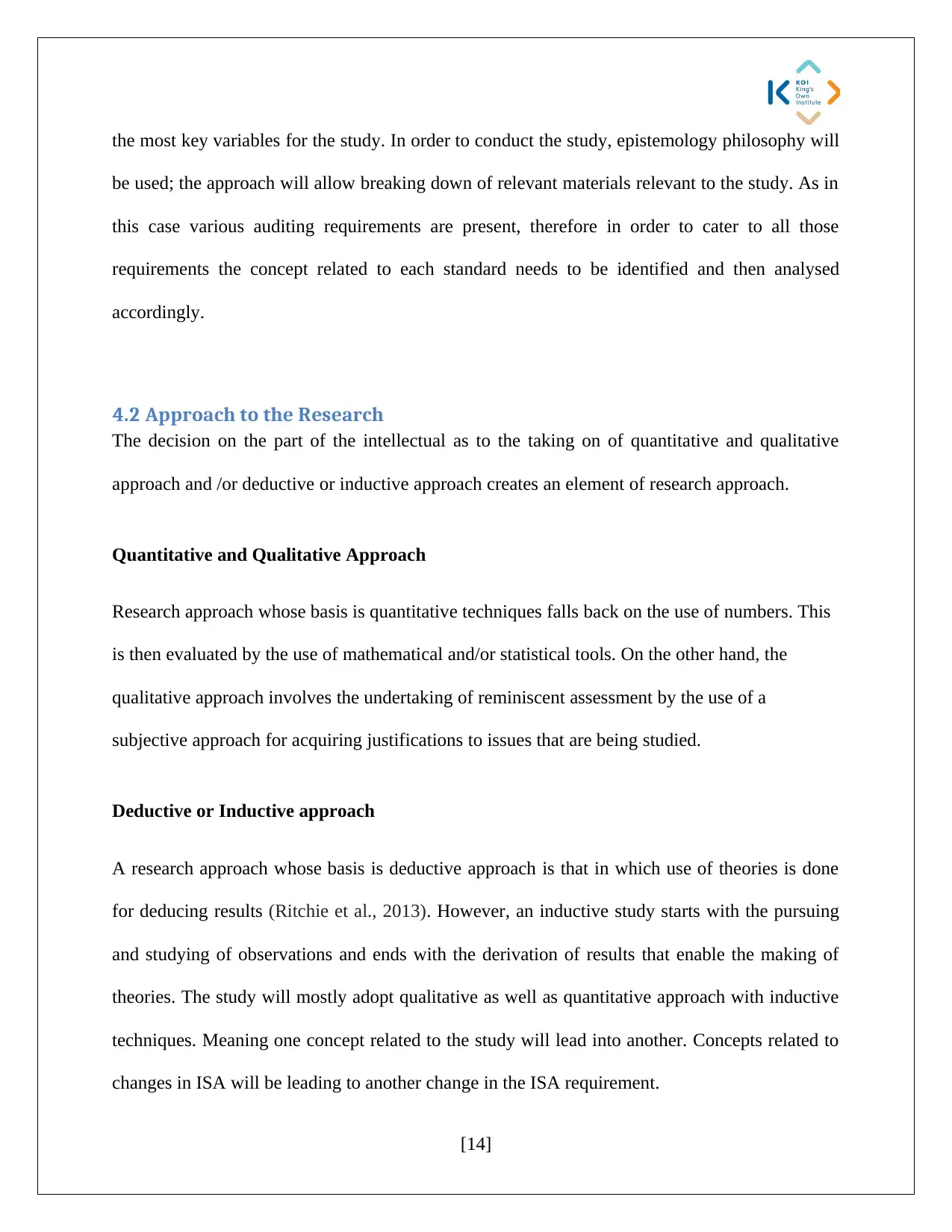
the most key variables for the study. In order to conduct the study, epistemology philosophy will
be used; the approach will allow breaking down of relevant materials relevant to the study. As in
this case various auditing requirements are present, therefore in order to cater to all those
requirements the concept related to each standard needs to be identified and then analysed
accordingly.
4.2 Approach to the Research
The decision on the part of the intellectual as to the taking on of quantitative and qualitative
approach and /or deductive or inductive approach creates an element of research approach.
Quantitative and Qualitative Approach
Research approach whose basis is quantitative techniques falls back on the use of numbers. This
is then evaluated by the use of mathematical and/or statistical tools. On the other hand, the
qualitative approach involves the undertaking of reminiscent assessment by the use of a
subjective approach for acquiring justifications to issues that are being studied.
Deductive or Inductive approach
A research approach whose basis is deductive approach is that in which use of theories is done
for deducing results (Ritchie et al., 2013). However, an inductive study starts with the pursuing
and studying of observations and ends with the derivation of results that enable the making of
theories. The study will mostly adopt qualitative as well as quantitative approach with inductive
techniques. Meaning one concept related to the study will lead into another. Concepts related to
changes in ISA will be leading to another change in the ISA requirement.
[14]
be used; the approach will allow breaking down of relevant materials relevant to the study. As in
this case various auditing requirements are present, therefore in order to cater to all those
requirements the concept related to each standard needs to be identified and then analysed
accordingly.
4.2 Approach to the Research
The decision on the part of the intellectual as to the taking on of quantitative and qualitative
approach and /or deductive or inductive approach creates an element of research approach.
Quantitative and Qualitative Approach
Research approach whose basis is quantitative techniques falls back on the use of numbers. This
is then evaluated by the use of mathematical and/or statistical tools. On the other hand, the
qualitative approach involves the undertaking of reminiscent assessment by the use of a
subjective approach for acquiring justifications to issues that are being studied.
Deductive or Inductive approach
A research approach whose basis is deductive approach is that in which use of theories is done
for deducing results (Ritchie et al., 2013). However, an inductive study starts with the pursuing
and studying of observations and ends with the derivation of results that enable the making of
theories. The study will mostly adopt qualitative as well as quantitative approach with inductive
techniques. Meaning one concept related to the study will lead into another. Concepts related to
changes in ISA will be leading to another change in the ISA requirement.
[14]
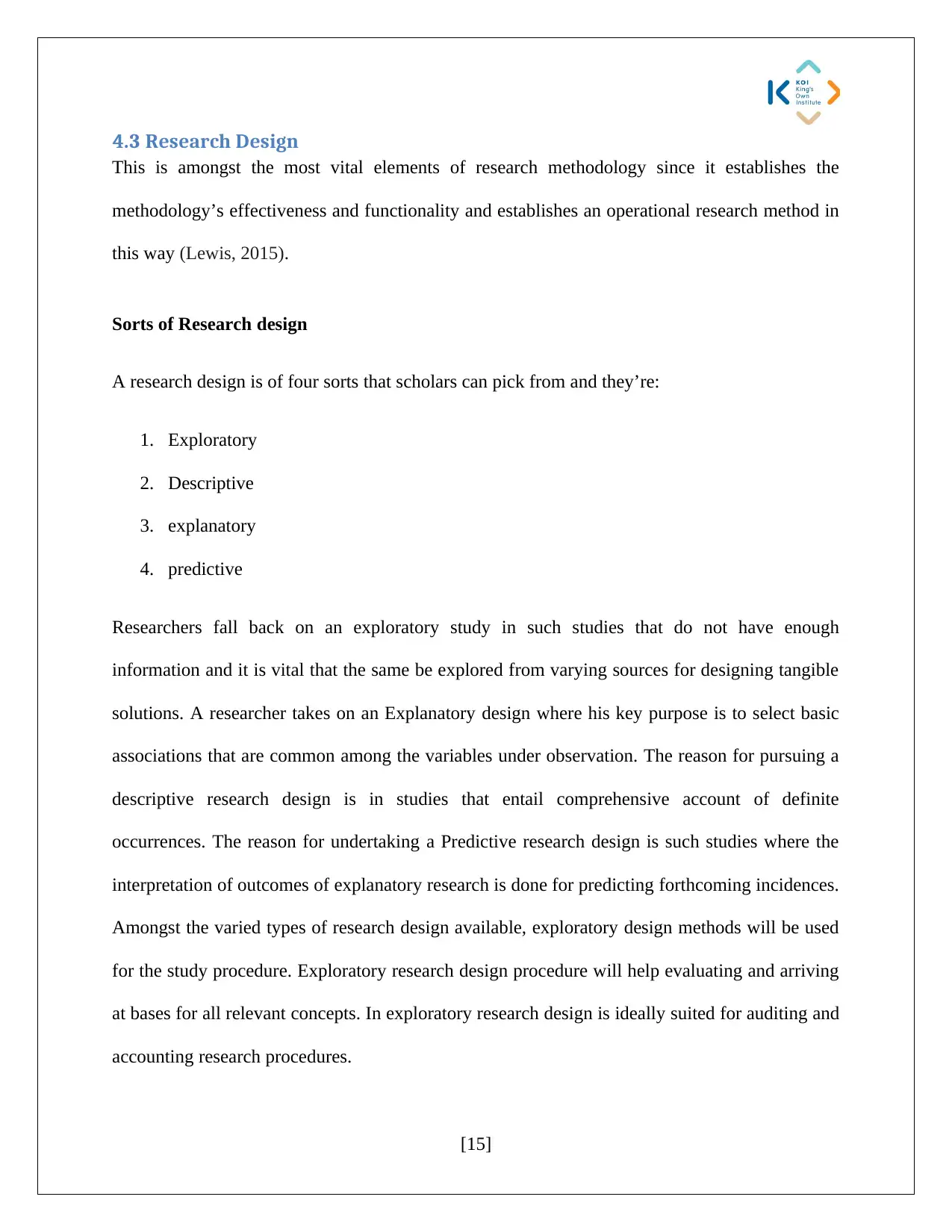
4.3 Research Design
This is amongst the most vital elements of research methodology since it establishes the
methodology’s effectiveness and functionality and establishes an operational research method in
this way (Lewis, 2015).
Sorts of Research design
A research design is of four sorts that scholars can pick from and they’re:
1. Exploratory
2. Descriptive
3. explanatory
4. predictive
Researchers fall back on an exploratory study in such studies that do not have enough
information and it is vital that the same be explored from varying sources for designing tangible
solutions. A researcher takes on an Explanatory design where his key purpose is to select basic
associations that are common among the variables under observation. The reason for pursuing a
descriptive research design is in studies that entail comprehensive account of definite
occurrences. The reason for undertaking a Predictive research design is such studies where the
interpretation of outcomes of explanatory research is done for predicting forthcoming incidences.
Amongst the varied types of research design available, exploratory design methods will be used
for the study procedure. Exploratory research design procedure will help evaluating and arriving
at bases for all relevant concepts. In exploratory research design is ideally suited for auditing and
accounting research procedures.
[15]
This is amongst the most vital elements of research methodology since it establishes the
methodology’s effectiveness and functionality and establishes an operational research method in
this way (Lewis, 2015).
Sorts of Research design
A research design is of four sorts that scholars can pick from and they’re:
1. Exploratory
2. Descriptive
3. explanatory
4. predictive
Researchers fall back on an exploratory study in such studies that do not have enough
information and it is vital that the same be explored from varying sources for designing tangible
solutions. A researcher takes on an Explanatory design where his key purpose is to select basic
associations that are common among the variables under observation. The reason for pursuing a
descriptive research design is in studies that entail comprehensive account of definite
occurrences. The reason for undertaking a Predictive research design is such studies where the
interpretation of outcomes of explanatory research is done for predicting forthcoming incidences.
Amongst the varied types of research design available, exploratory design methods will be used
for the study procedure. Exploratory research design procedure will help evaluating and arriving
at bases for all relevant concepts. In exploratory research design is ideally suited for auditing and
accounting research procedures.
[15]

4.4 Research method
The best description of Research methods is that they are the tools that a researcher adopts for
collecting information from prime sources with the objective of sustaining research design and
achieving research objectives. A researcher can adopt diverse research methods and we discuss
them next.
Tools for Research
Observation: Observations are primarily of two sorts and they are structured and participative.
The adoption of structured observations is done in qualitative studies in which a researcher’s
observations are systematically recorded based on predefined segments. The adoption of
Participative observation is necessary for quantitative studies where researcher participates in the
actual set up in conjunction with more sample participants and infers information on the basis of
individual experiences.
Interviews: A scholar can adopt personal interviews of two sorts and they’re Structured and
semi-structured. In a structured interview, the interviewee performs in line with a predefined
code that’s established by the interviewer and thus has limited flexibility. A Semi-structured
interview is a more flexible interview in which some sets of prefixed behavior guides the
conversation among the interviewer and interviewee though not fully controlling it.
Questionnaires: For a specified research, based on the sort of study and the research objectives,
that research can pick from close and open-ended questionnaires. A listing of questions having
pre-set opinion options make up a close-ended questionnaire and the sample respondent must
make a choice from the choices that are given. However, open-ended questionnaires don’t
impose any restrictions on the respondents as far as providing an opinion is concerned.
[16]
The best description of Research methods is that they are the tools that a researcher adopts for
collecting information from prime sources with the objective of sustaining research design and
achieving research objectives. A researcher can adopt diverse research methods and we discuss
them next.
Tools for Research
Observation: Observations are primarily of two sorts and they are structured and participative.
The adoption of structured observations is done in qualitative studies in which a researcher’s
observations are systematically recorded based on predefined segments. The adoption of
Participative observation is necessary for quantitative studies where researcher participates in the
actual set up in conjunction with more sample participants and infers information on the basis of
individual experiences.
Interviews: A scholar can adopt personal interviews of two sorts and they’re Structured and
semi-structured. In a structured interview, the interviewee performs in line with a predefined
code that’s established by the interviewer and thus has limited flexibility. A Semi-structured
interview is a more flexible interview in which some sets of prefixed behavior guides the
conversation among the interviewer and interviewee though not fully controlling it.
Questionnaires: For a specified research, based on the sort of study and the research objectives,
that research can pick from close and open-ended questionnaires. A listing of questions having
pre-set opinion options make up a close-ended questionnaire and the sample respondent must
make a choice from the choices that are given. However, open-ended questionnaires don’t
impose any restrictions on the respondents as far as providing an opinion is concerned.
[16]
Secure Best Marks with AI Grader
Need help grading? Try our AI Grader for instant feedback on your assignments.
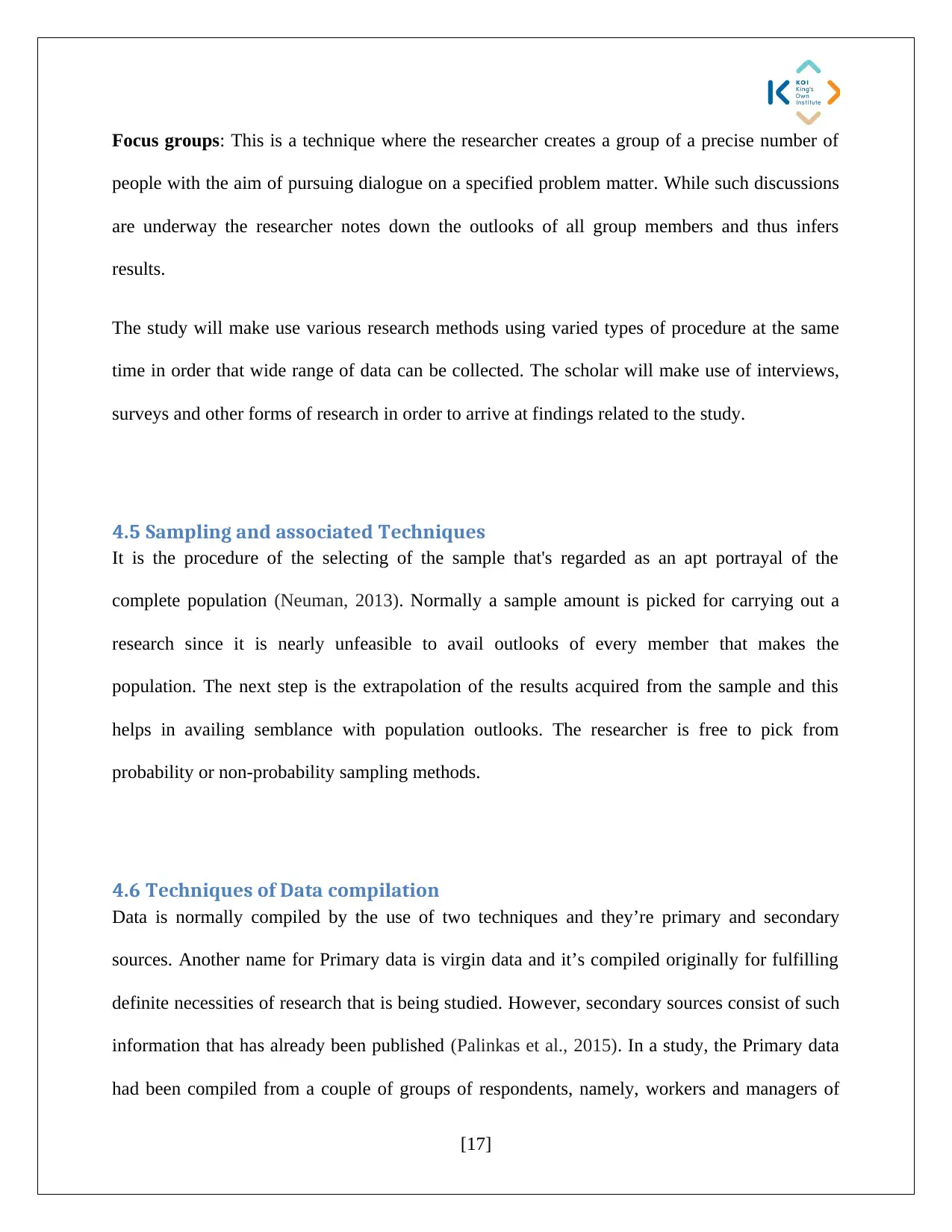
Focus groups: This is a technique where the researcher creates a group of a precise number of
people with the aim of pursuing dialogue on a specified problem matter. While such discussions
are underway the researcher notes down the outlooks of all group members and thus infers
results.
The study will make use various research methods using varied types of procedure at the same
time in order that wide range of data can be collected. The scholar will make use of interviews,
surveys and other forms of research in order to arrive at findings related to the study.
4.5 Sampling and associated Techniques
It is the procedure of the selecting of the sample that's regarded as an apt portrayal of the
complete population (Neuman, 2013). Normally a sample amount is picked for carrying out a
research since it is nearly unfeasible to avail outlooks of every member that makes the
population. The next step is the extrapolation of the results acquired from the sample and this
helps in availing semblance with population outlooks. The researcher is free to pick from
probability or non-probability sampling methods.
4.6 Techniques of Data compilation
Data is normally compiled by the use of two techniques and they’re primary and secondary
sources. Another name for Primary data is virgin data and it’s compiled originally for fulfilling
definite necessities of research that is being studied. However, secondary sources consist of such
information that has already been published (Palinkas et al., 2015). In a study, the Primary data
had been compiled from a couple of groups of respondents, namely, workers and managers of
[17]
people with the aim of pursuing dialogue on a specified problem matter. While such discussions
are underway the researcher notes down the outlooks of all group members and thus infers
results.
The study will make use various research methods using varied types of procedure at the same
time in order that wide range of data can be collected. The scholar will make use of interviews,
surveys and other forms of research in order to arrive at findings related to the study.
4.5 Sampling and associated Techniques
It is the procedure of the selecting of the sample that's regarded as an apt portrayal of the
complete population (Neuman, 2013). Normally a sample amount is picked for carrying out a
research since it is nearly unfeasible to avail outlooks of every member that makes the
population. The next step is the extrapolation of the results acquired from the sample and this
helps in availing semblance with population outlooks. The researcher is free to pick from
probability or non-probability sampling methods.
4.6 Techniques of Data compilation
Data is normally compiled by the use of two techniques and they’re primary and secondary
sources. Another name for Primary data is virgin data and it’s compiled originally for fulfilling
definite necessities of research that is being studied. However, secondary sources consist of such
information that has already been published (Palinkas et al., 2015). In a study, the Primary data
had been compiled from a couple of groups of respondents, namely, workers and managers of
[17]

case corporations. Several of the workers had been approached in person in workplaces of the
corporations arbitrarily and appealed to take part in surveys. After they had agreed they were
provided with questionnaires information was compiled. As approaching all workers in person
wasn’t possible email ids had been acquired from their workplaces and they had been requested
to chip in by filling up the questionnaires that they were sent via emails and answer via email.
The managers had been approached in person for interviews. This was done by arranging
appointments and meet up with them at the specified time. Collecting data and perspectives
from all auditors in Australia employed at auditing firms is not possible; hence the scholar will
adopt sampling techniques to arrive at findings related to the study.
The sources from compiling Secondary data in studies have been several and include articles,
books, journals, newsletters, government periodicals, magazines, newspapers and online
publications, to name a few.
4.7 Data Analysis Techniques
Frequency analysis in conjunction with more mathematical and statistical tools had been made
use of for the analysis of quantitative data that’s acquired from questionnaires. The recording and
analysis of the data have been done by the use of MsExcel Toolpack. A descriptive analysis has
been done of the Qualitative data that’s been acquired through interview schedules. The study
will analyze qualitative data according to descriptive analysis methods and it will adopt
statistical procedures for quantitative analysis.
[18]
corporations arbitrarily and appealed to take part in surveys. After they had agreed they were
provided with questionnaires information was compiled. As approaching all workers in person
wasn’t possible email ids had been acquired from their workplaces and they had been requested
to chip in by filling up the questionnaires that they were sent via emails and answer via email.
The managers had been approached in person for interviews. This was done by arranging
appointments and meet up with them at the specified time. Collecting data and perspectives
from all auditors in Australia employed at auditing firms is not possible; hence the scholar will
adopt sampling techniques to arrive at findings related to the study.
The sources from compiling Secondary data in studies have been several and include articles,
books, journals, newsletters, government periodicals, magazines, newspapers and online
publications, to name a few.
4.7 Data Analysis Techniques
Frequency analysis in conjunction with more mathematical and statistical tools had been made
use of for the analysis of quantitative data that’s acquired from questionnaires. The recording and
analysis of the data have been done by the use of MsExcel Toolpack. A descriptive analysis has
been done of the Qualitative data that’s been acquired through interview schedules. The study
will analyze qualitative data according to descriptive analysis methods and it will adopt
statistical procedures for quantitative analysis.
[18]
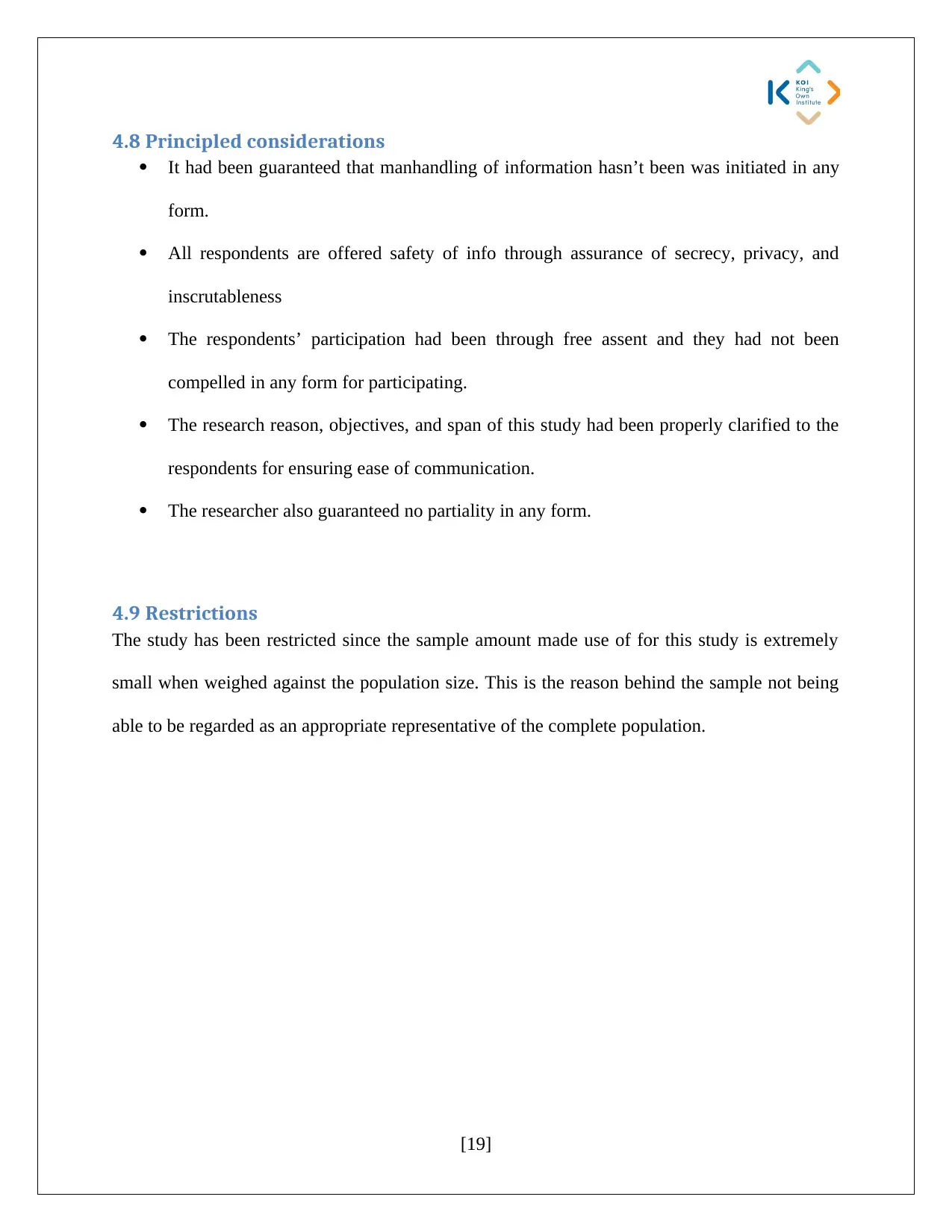
4.8 Principled considerations
It had been guaranteed that manhandling of information hasn’t been was initiated in any
form.
All respondents are offered safety of info through assurance of secrecy, privacy, and
inscrutableness
The respondents’ participation had been through free assent and they had not been
compelled in any form for participating.
The research reason, objectives, and span of this study had been properly clarified to the
respondents for ensuring ease of communication.
The researcher also guaranteed no partiality in any form.
4.9 Restrictions
The study has been restricted since the sample amount made use of for this study is extremely
small when weighed against the population size. This is the reason behind the sample not being
able to be regarded as an appropriate representative of the complete population.
[19]
It had been guaranteed that manhandling of information hasn’t been was initiated in any
form.
All respondents are offered safety of info through assurance of secrecy, privacy, and
inscrutableness
The respondents’ participation had been through free assent and they had not been
compelled in any form for participating.
The research reason, objectives, and span of this study had been properly clarified to the
respondents for ensuring ease of communication.
The researcher also guaranteed no partiality in any form.
4.9 Restrictions
The study has been restricted since the sample amount made use of for this study is extremely
small when weighed against the population size. This is the reason behind the sample not being
able to be regarded as an appropriate representative of the complete population.
[19]
Paraphrase This Document
Need a fresh take? Get an instant paraphrase of this document with our AI Paraphraser

5.0 Reference Lists
Bedard, J.C., Sutton, S.G., Arnold, V. and Phillips, J.R., 2012. Another piece of the
“expectations gap”: What do investors know about auditor involvement with information in the
annual report?. Current Issues in Auditing, 6(1), pp.A17-A30.
Bell, T.B. and Griffin, J.B., 2012. Commentary on auditing high-uncertainty fair value
estimates. Auditing: A Journal of Practice & Theory, 31(1), pp.147-155.
Carcello, J.V., Hermanson, D.R. and Ye, Z., 2011. Corporate governance research in accounting
and auditing: Insights, practice implications, and future research directions. Auditing: A Journal
of Practice & Theory, 30(3), pp.1-31.
Christensen, B.E., Glover, S.M. and Wolfe, C.J., 2014. Do critical audit matter paragraphs in the
audit report change nonprofessional investors' decision to invest?. Auditing: A Journal of
Practice & Theory, 33(4), pp.71-93.
Gerakos, J. and Syverson, C., 2015. Competition in the audit market: Policy
implications. Journal of Accounting Research, 53(4), pp.725-775.
Gold, A., Gronewold, U. and Pott, C., 2012. The ISA 700 auditor's report and the audit
expectation gap–do explanations matter?. International Journal of Auditing, 16(3), pp.286-307.
Gray, G.L., Turner, J.L., Coram, P.J. and Mock, T.J., 2011. Perceptions and misperceptions
regarding the unqualified auditor's report by financial statement preparers, users, and
auditors. Accounting Horizons, 25(4), pp.659-684.
Lennox, C. and Pittman, J., 2010. Auditing the auditors: Evidence on the recent reforms to the
external monitoring of audit firms. Journal of Accounting and Economics, 49(1-2), pp.84-103.
Lewis, S., 2015. Qualitative inquiry and research design: Choosing among five
approaches. Health promotion practice, 16(4), pp.473-475.
Matthews, B. and Ross, L., 2010. Research methods. Longman/Pearson Education.
[20]
Bedard, J.C., Sutton, S.G., Arnold, V. and Phillips, J.R., 2012. Another piece of the
“expectations gap”: What do investors know about auditor involvement with information in the
annual report?. Current Issues in Auditing, 6(1), pp.A17-A30.
Bell, T.B. and Griffin, J.B., 2012. Commentary on auditing high-uncertainty fair value
estimates. Auditing: A Journal of Practice & Theory, 31(1), pp.147-155.
Carcello, J.V., Hermanson, D.R. and Ye, Z., 2011. Corporate governance research in accounting
and auditing: Insights, practice implications, and future research directions. Auditing: A Journal
of Practice & Theory, 30(3), pp.1-31.
Christensen, B.E., Glover, S.M. and Wolfe, C.J., 2014. Do critical audit matter paragraphs in the
audit report change nonprofessional investors' decision to invest?. Auditing: A Journal of
Practice & Theory, 33(4), pp.71-93.
Gerakos, J. and Syverson, C., 2015. Competition in the audit market: Policy
implications. Journal of Accounting Research, 53(4), pp.725-775.
Gold, A., Gronewold, U. and Pott, C., 2012. The ISA 700 auditor's report and the audit
expectation gap–do explanations matter?. International Journal of Auditing, 16(3), pp.286-307.
Gray, G.L., Turner, J.L., Coram, P.J. and Mock, T.J., 2011. Perceptions and misperceptions
regarding the unqualified auditor's report by financial statement preparers, users, and
auditors. Accounting Horizons, 25(4), pp.659-684.
Lennox, C. and Pittman, J., 2010. Auditing the auditors: Evidence on the recent reforms to the
external monitoring of audit firms. Journal of Accounting and Economics, 49(1-2), pp.84-103.
Lewis, S., 2015. Qualitative inquiry and research design: Choosing among five
approaches. Health promotion practice, 16(4), pp.473-475.
Matthews, B. and Ross, L., 2010. Research methods. Longman/Pearson Education.
[20]
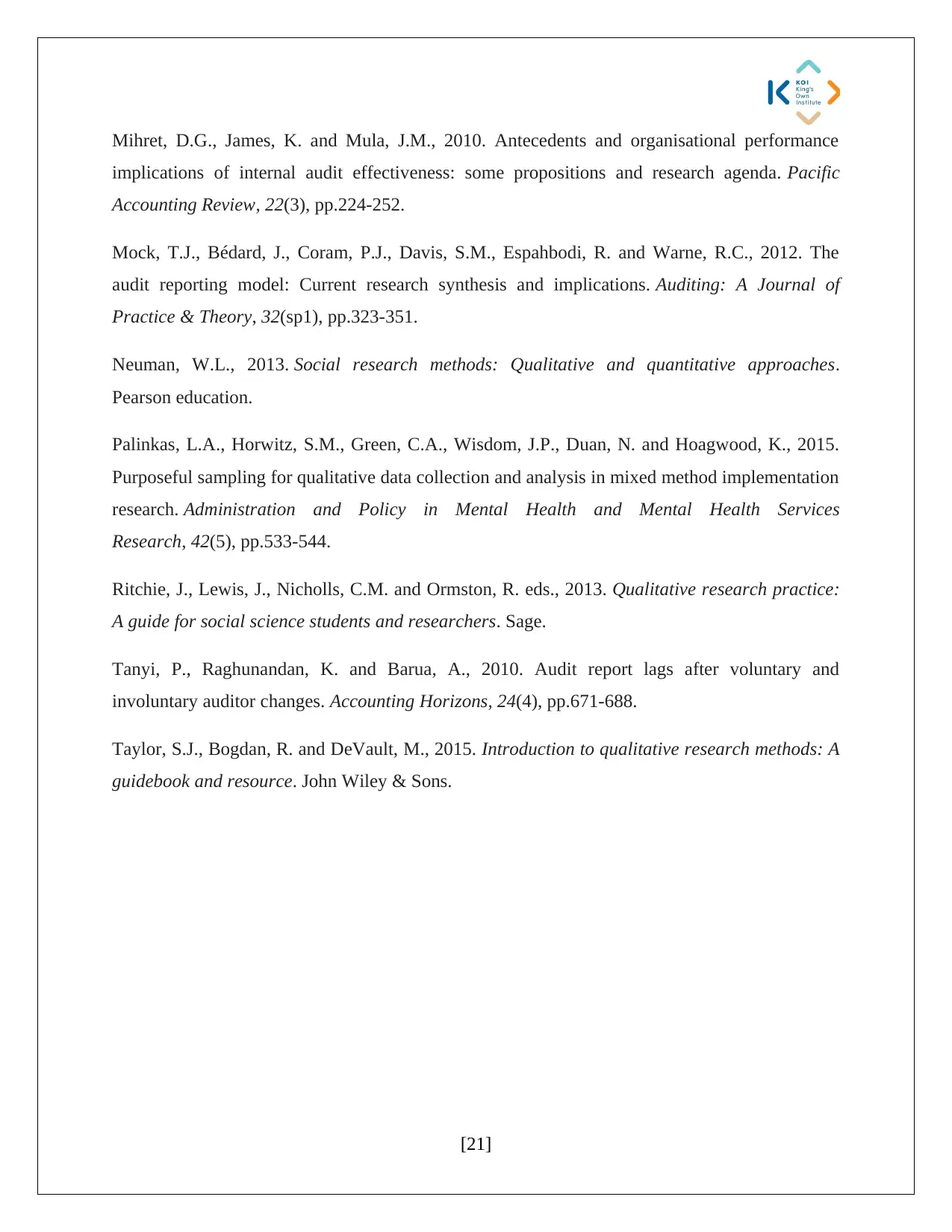
Mihret, D.G., James, K. and Mula, J.M., 2010. Antecedents and organisational performance
implications of internal audit effectiveness: some propositions and research agenda. Pacific
Accounting Review, 22(3), pp.224-252.
Mock, T.J., Bédard, J., Coram, P.J., Davis, S.M., Espahbodi, R. and Warne, R.C., 2012. The
audit reporting model: Current research synthesis and implications. Auditing: A Journal of
Practice & Theory, 32(sp1), pp.323-351.
Neuman, W.L., 2013. Social research methods: Qualitative and quantitative approaches.
Pearson education.
Palinkas, L.A., Horwitz, S.M., Green, C.A., Wisdom, J.P., Duan, N. and Hoagwood, K., 2015.
Purposeful sampling for qualitative data collection and analysis in mixed method implementation
research. Administration and Policy in Mental Health and Mental Health Services
Research, 42(5), pp.533-544.
Ritchie, J., Lewis, J., Nicholls, C.M. and Ormston, R. eds., 2013. Qualitative research practice:
A guide for social science students and researchers. Sage.
Tanyi, P., Raghunandan, K. and Barua, A., 2010. Audit report lags after voluntary and
involuntary auditor changes. Accounting Horizons, 24(4), pp.671-688.
Taylor, S.J., Bogdan, R. and DeVault, M., 2015. Introduction to qualitative research methods: A
guidebook and resource. John Wiley & Sons.
[21]
implications of internal audit effectiveness: some propositions and research agenda. Pacific
Accounting Review, 22(3), pp.224-252.
Mock, T.J., Bédard, J., Coram, P.J., Davis, S.M., Espahbodi, R. and Warne, R.C., 2012. The
audit reporting model: Current research synthesis and implications. Auditing: A Journal of
Practice & Theory, 32(sp1), pp.323-351.
Neuman, W.L., 2013. Social research methods: Qualitative and quantitative approaches.
Pearson education.
Palinkas, L.A., Horwitz, S.M., Green, C.A., Wisdom, J.P., Duan, N. and Hoagwood, K., 2015.
Purposeful sampling for qualitative data collection and analysis in mixed method implementation
research. Administration and Policy in Mental Health and Mental Health Services
Research, 42(5), pp.533-544.
Ritchie, J., Lewis, J., Nicholls, C.M. and Ormston, R. eds., 2013. Qualitative research practice:
A guide for social science students and researchers. Sage.
Tanyi, P., Raghunandan, K. and Barua, A., 2010. Audit report lags after voluntary and
involuntary auditor changes. Accounting Horizons, 24(4), pp.671-688.
Taylor, S.J., Bogdan, R. and DeVault, M., 2015. Introduction to qualitative research methods: A
guidebook and resource. John Wiley & Sons.
[21]
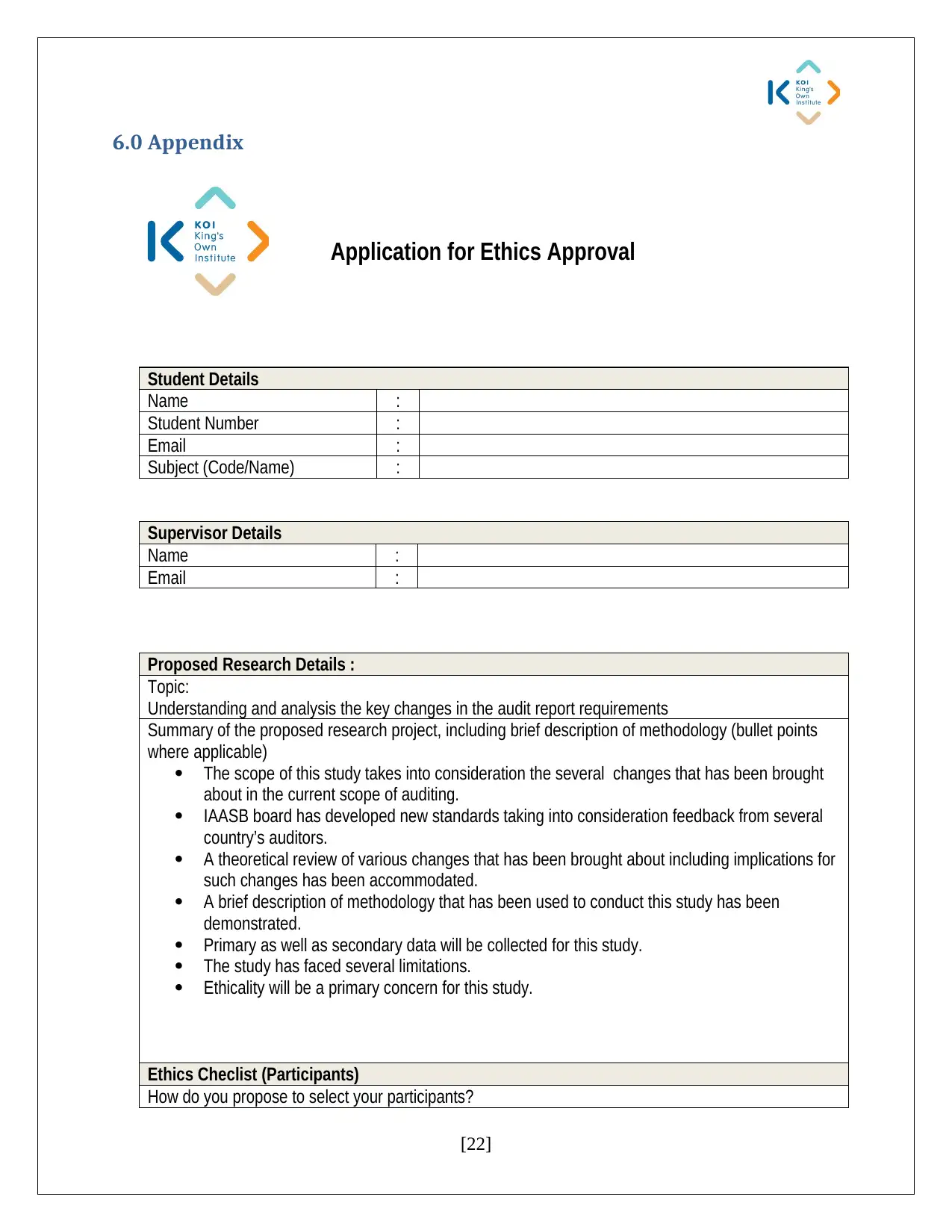
6.0 Appendix
Application for Ethics Approval
Student Details
Name :
Student Number :
Email :
Subject (Code/Name) :
Supervisor Details
Name :
Email :
Proposed Research Details :
Topic:
Understanding and analysis the key changes in the audit report requirements
Summary of the proposed research project, including brief description of methodology (bullet points
where applicable)
The scope of this study takes into consideration the several changes that has been brought
about in the current scope of auditing.
IAASB board has developed new standards taking into consideration feedback from several
country’s auditors.
A theoretical review of various changes that has been brought about including implications for
such changes has been accommodated.
A brief description of methodology that has been used to conduct this study has been
demonstrated.
Primary as well as secondary data will be collected for this study.
The study has faced several limitations.
Ethicality will be a primary concern for this study.
Ethics Checlist (Participants)
How do you propose to select your participants?
[22]
Application for Ethics Approval
Student Details
Name :
Student Number :
Email :
Subject (Code/Name) :
Supervisor Details
Name :
Email :
Proposed Research Details :
Topic:
Understanding and analysis the key changes in the audit report requirements
Summary of the proposed research project, including brief description of methodology (bullet points
where applicable)
The scope of this study takes into consideration the several changes that has been brought
about in the current scope of auditing.
IAASB board has developed new standards taking into consideration feedback from several
country’s auditors.
A theoretical review of various changes that has been brought about including implications for
such changes has been accommodated.
A brief description of methodology that has been used to conduct this study has been
demonstrated.
Primary as well as secondary data will be collected for this study.
The study has faced several limitations.
Ethicality will be a primary concern for this study.
Ethics Checlist (Participants)
How do you propose to select your participants?
[22]
Secure Best Marks with AI Grader
Need help grading? Try our AI Grader for instant feedback on your assignments.
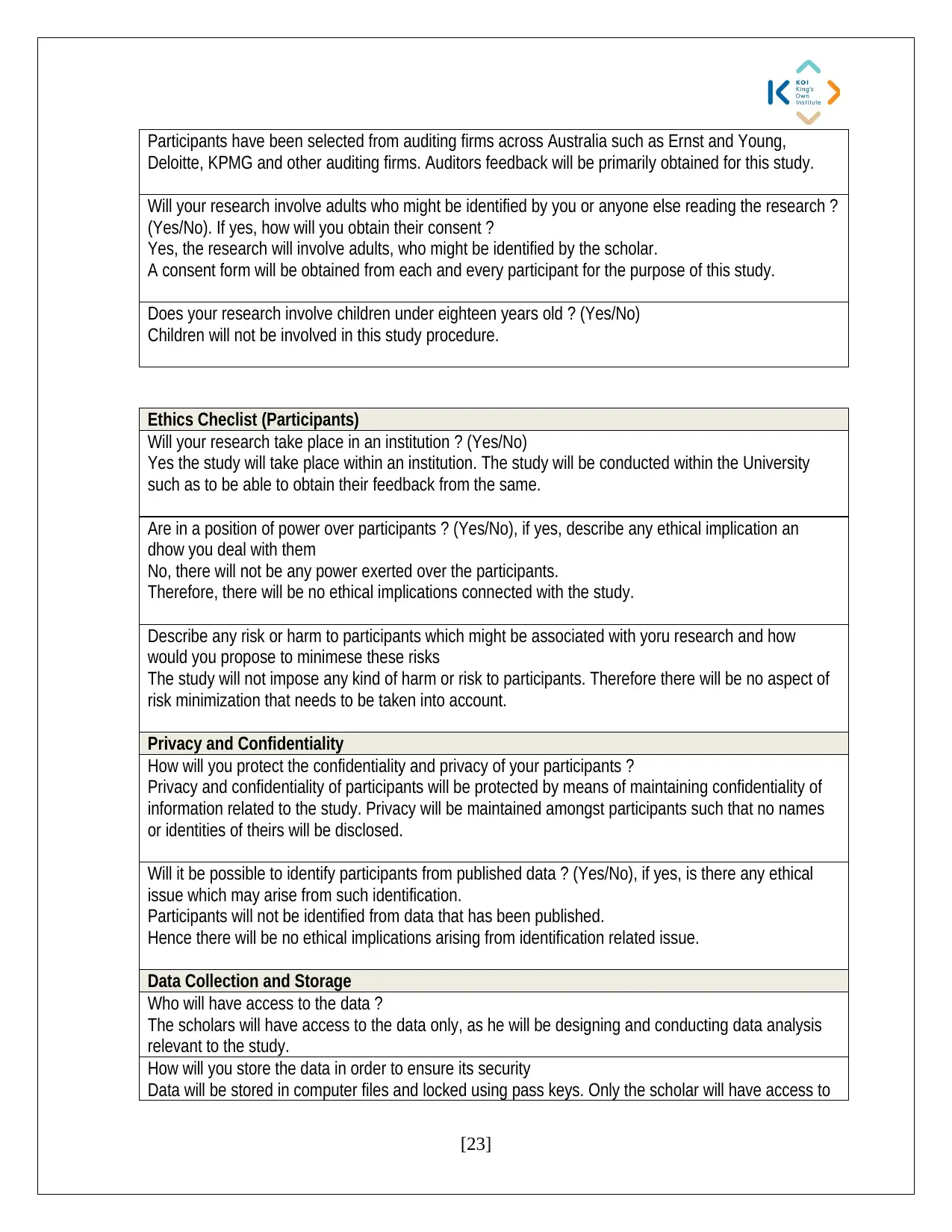
Participants have been selected from auditing firms across Australia such as Ernst and Young,
Deloitte, KPMG and other auditing firms. Auditors feedback will be primarily obtained for this study.
Will your research involve adults who might be identified by you or anyone else reading the research ?
(Yes/No). If yes, how will you obtain their consent ?
Yes, the research will involve adults, who might be identified by the scholar.
A consent form will be obtained from each and every participant for the purpose of this study.
Does your research involve children under eighteen years old ? (Yes/No)
Children will not be involved in this study procedure.
Ethics Checlist (Participants)
Will your research take place in an institution ? (Yes/No)
Yes the study will take place within an institution. The study will be conducted within the University
such as to be able to obtain their feedback from the same.
Are in a position of power over participants ? (Yes/No), if yes, describe any ethical implication an
dhow you deal with them
No, there will not be any power exerted over the participants.
Therefore, there will be no ethical implications connected with the study.
Describe any risk or harm to participants which might be associated with yoru research and how
would you propose to minimese these risks
The study will not impose any kind of harm or risk to participants. Therefore there will be no aspect of
risk minimization that needs to be taken into account.
Privacy and Confidentiality
How will you protect the confidentiality and privacy of your participants ?
Privacy and confidentiality of participants will be protected by means of maintaining confidentiality of
information related to the study. Privacy will be maintained amongst participants such that no names
or identities of theirs will be disclosed.
Will it be possible to identify participants from published data ? (Yes/No), if yes, is there any ethical
issue which may arise from such identification.
Participants will not be identified from data that has been published.
Hence there will be no ethical implications arising from identification related issue.
Data Collection and Storage
Who will have access to the data ?
The scholars will have access to the data only, as he will be designing and conducting data analysis
relevant to the study.
How will you store the data in order to ensure its security
Data will be stored in computer files and locked using pass keys. Only the scholar will have access to
[23]
Deloitte, KPMG and other auditing firms. Auditors feedback will be primarily obtained for this study.
Will your research involve adults who might be identified by you or anyone else reading the research ?
(Yes/No). If yes, how will you obtain their consent ?
Yes, the research will involve adults, who might be identified by the scholar.
A consent form will be obtained from each and every participant for the purpose of this study.
Does your research involve children under eighteen years old ? (Yes/No)
Children will not be involved in this study procedure.
Ethics Checlist (Participants)
Will your research take place in an institution ? (Yes/No)
Yes the study will take place within an institution. The study will be conducted within the University
such as to be able to obtain their feedback from the same.
Are in a position of power over participants ? (Yes/No), if yes, describe any ethical implication an
dhow you deal with them
No, there will not be any power exerted over the participants.
Therefore, there will be no ethical implications connected with the study.
Describe any risk or harm to participants which might be associated with yoru research and how
would you propose to minimese these risks
The study will not impose any kind of harm or risk to participants. Therefore there will be no aspect of
risk minimization that needs to be taken into account.
Privacy and Confidentiality
How will you protect the confidentiality and privacy of your participants ?
Privacy and confidentiality of participants will be protected by means of maintaining confidentiality of
information related to the study. Privacy will be maintained amongst participants such that no names
or identities of theirs will be disclosed.
Will it be possible to identify participants from published data ? (Yes/No), if yes, is there any ethical
issue which may arise from such identification.
Participants will not be identified from data that has been published.
Hence there will be no ethical implications arising from identification related issue.
Data Collection and Storage
Who will have access to the data ?
The scholars will have access to the data only, as he will be designing and conducting data analysis
relevant to the study.
How will you store the data in order to ensure its security
Data will be stored in computer files and locked using pass keys. Only the scholar will have access to
[23]

the passkey therefore, it will not be available easily to any other person.
[24]
[24]
1 out of 24
Related Documents
Your All-in-One AI-Powered Toolkit for Academic Success.
+13062052269
info@desklib.com
Available 24*7 on WhatsApp / Email
![[object Object]](/_next/static/media/star-bottom.7253800d.svg)
Unlock your academic potential
© 2024 | Zucol Services PVT LTD | All rights reserved.





